Our Verdict
The GeForce GTX 1660 Ti balances price, performance, and features to create a compelling mainstream offering with improved performance for the midrange market.
For
- Cuts the cruft
- Efficient and overclockable
- Good overall balance
Against
- Only ties the GTX 1070
- RTX 2060 doesn't cost much more
- What, only 12nm?
PC Gamer's got your back
When it comes to picking the best graphics card from among the many contenders, I admit I prefer more features rather than seeing things get cut—you might not get immediate use out of the extra stuff, but at least it's there. Predicting the future is a tricky business, however, and the gamers have spoken. Real-time ray tracing might sound cool, but if it tanks performance, we're just fine without it. And so, half a year after unveiling its Turing architecture, Nvidia is rolling out the mainstream options, minus the ray tracing and deep learning. It's everything the gamers wanted from Turing, with none of the extra bloat. Say hello to the GTX 1660 Ti.
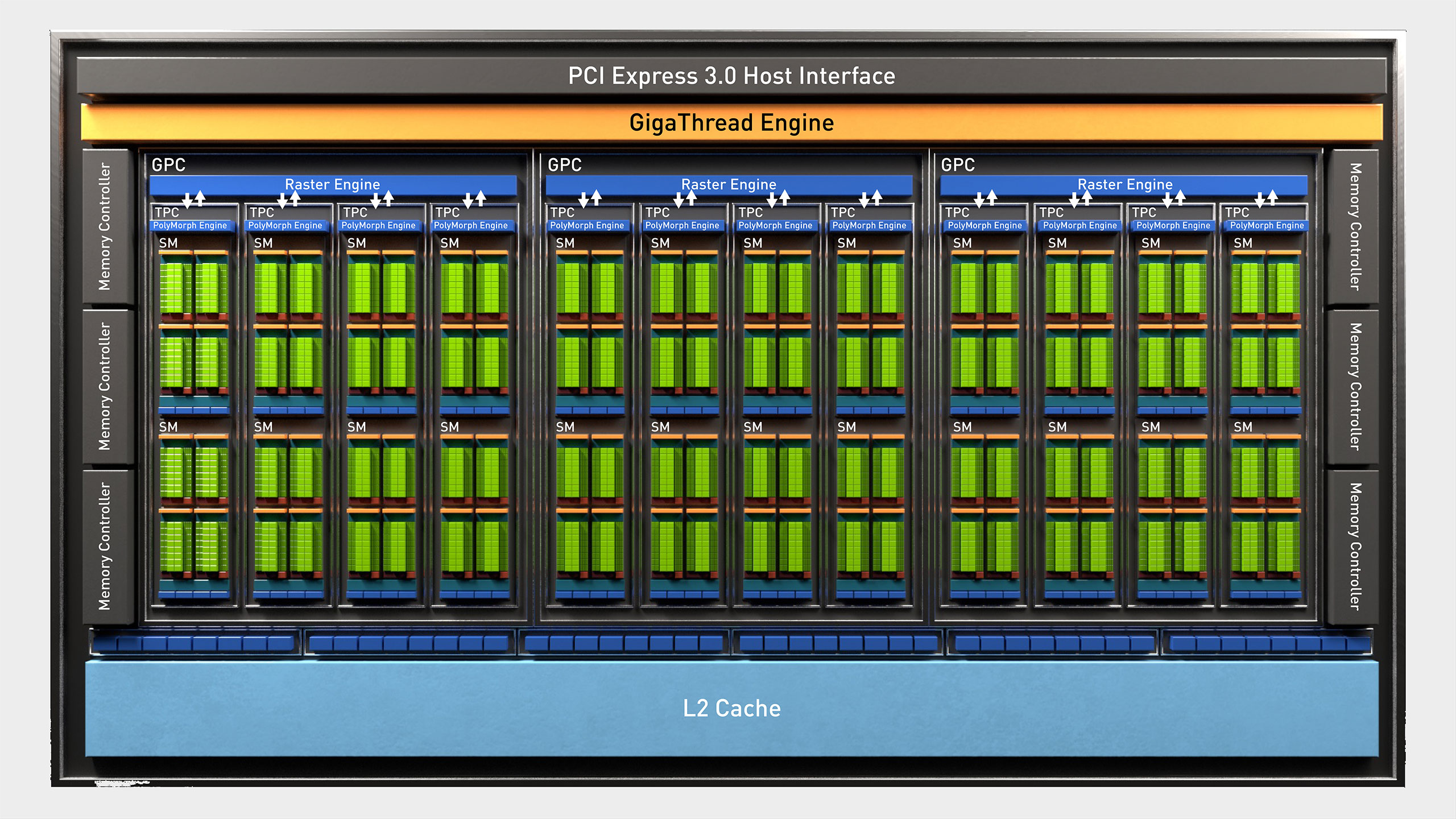
Architecture: TU116
Lithography: TSMC 12nm FinFET
Transistor Count: 6.6 billion
Die Size: 284mm2
SMs: 24
CUDA Cores: 1,536
Render Outputs: 48
Texture Units: 96
Base Clock: 1500MHz
Boost Clock: 1770MHz
FP32 GFLOPS: 5,437
Memory Speed: 12 GT/s
Bus Width: 192-bit
GDDR6 Capacity: 6GB
Memory Bandwidth: 288GB/s
TDP: 120W
Price: $279
The newest addition to the Turing family ends up being quite the departure from previous models, as the RT and Tensor cores that have been at the heart of the GeForce RTX story are gone. In their place you get… well, actually, you don't get anything. Instead, Nvidia ends up with a smaller and more affordable GPU. It also brings back the GTX branding, which is probably all for the best as ray-tracing on hardware below the RTX 2060 level doesn't make a lot of sense right now. But you do get the rest of the Turing architecture updates, including support for variable rate shading, simultaneous INT and FP operations, rapid FP16 packed math, and improvements in the cache hierarchy.
There are other improvements as well. Turing GPUs are manufactured using TSMC's 12nm FinFET process, and so far all of the GPUs use GDDR6 memory. The GTX 1660 Ti does drop the memory speed down to 12Gbps (compared to 14Gbps on the various RTX cards), which makes me wonder just how much memory overclocking headroom remains. More on that in a moment.
The GTX 1660 Ti isn't really everything gamers wanted, however, as it targets a mainstream audience. I think what people wanted was substantially higher performance at every price point, with more cores, VRAM, and performance. The GTX 1660 Ti does appear to hit that mark, by sticking relatively close to the outgoing GTX 1060 6GB price while increasing most of the specs. It has 20 percent more CUDA cores—and they're more capable cores as I already noted—a 50 percent increase in memory bandwidth thanks to GDDR6, and slightly higher clockspeeds that should result in 25 percent better theoretical performance (and it should be more than that thanks to the architecture changes). So the midrange market looks promising, but if you want a similar replacement for a GTX 1080 Ti, we didn't get that.
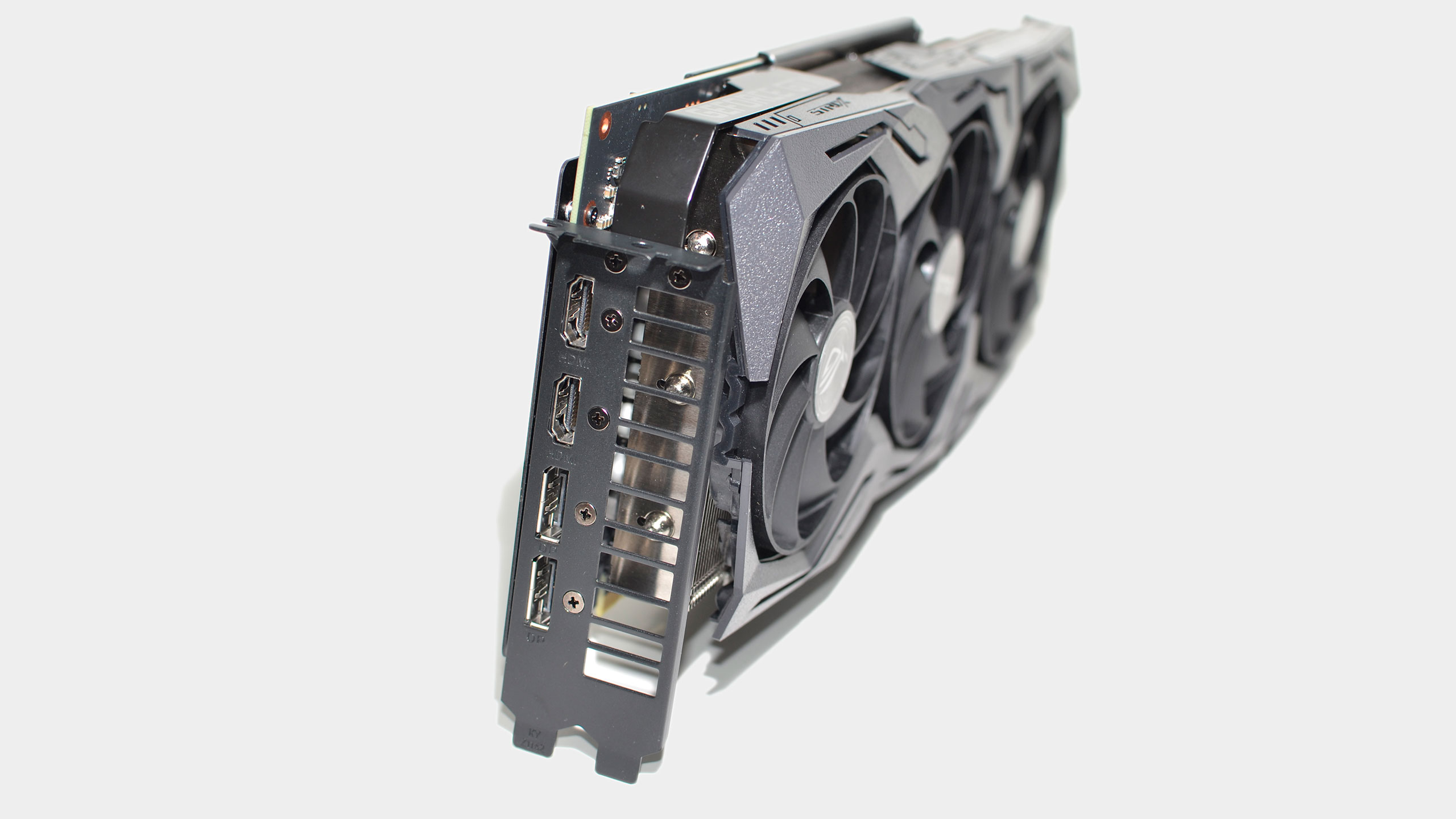
As far as the GeForce GTX 1660 Ti cards go, Nvidia isn't providing a reference design this round—there's no Founders Edition. That's typical of the lower tier cards from both AMD and Nvidia, though it comes with a catch. We know there are many GTX 1660 Ti models in the works from the AIB (Add-In Board) partners, running the usual gamut of reference clocks to uber-clocked models. Asus was the first AIB partner to get us a GTX 1660 Ti sample, just in time for the launch, which is what we're looking at today.
Asus sent its halo card: the ROG Strix GTX 1660 Ti O6G. It's priced at $329, a stone's throw from the RTX 2060, but it's also the kitchen sink approach. You get triple fans, addressable RGB lighting, dual BIOS, and a factory overclock to 1890MHz for the boost clock (1530MHz base clock). It's honestly overdesigned for a 120W TDP GPU, with an 8-pin PEG connector and a massive cooler, which means lower temperatures and noise levels. You can change between two performance modes at the flip of a switch, and there's also a "mute" button that will immediately disable all the RGB lighting if you desire.
I had limited time to test for the GTX 1660 Ti launch, unfortunately, so these initial results are at the factory stock clocks. Overclocking is possible of course, and it's something I'll look at in more depth over the next week. It's also possible to set the card at Nvidia's reference clocks, but VBIOS differences likely mean it will still run a bit faster, plus the cooling should help it hit higher boost clocks. So this test will give Nvidia's latest GPU a bit of an advantage over the other 'reference' cards I've tested, but the RX 590, 580, and 570 are all factory overclocked models, and I expect plenty of models will offer nearly the same level of performance as this Asus Strix card, only at a lower price point.
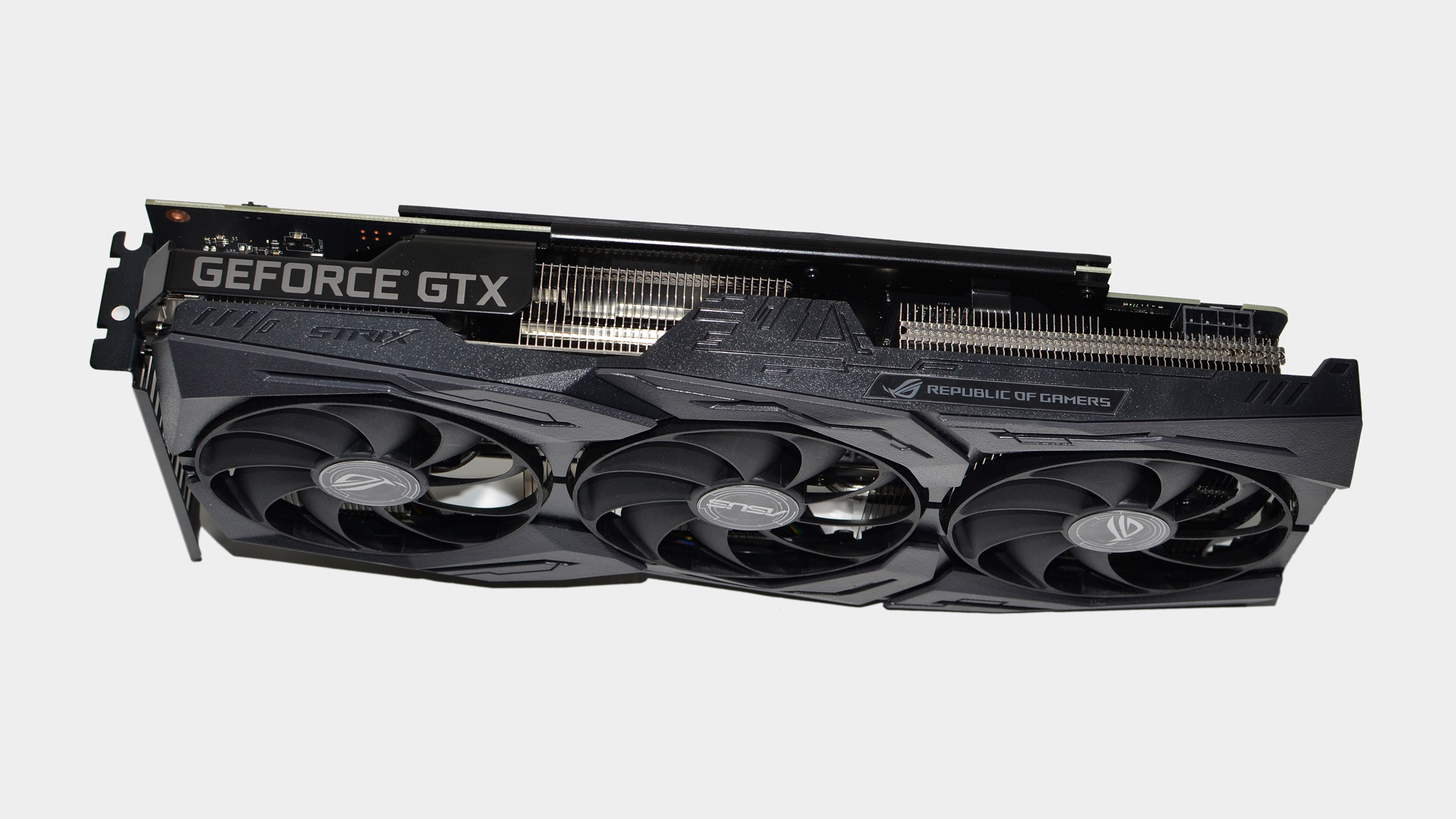
GeForce GTX 1660 Ti Overclocking
Let's talk a bit more about overclocking. Asus sent a relatively heavily overclocked card, and while the official boost clock is 1890MHz, I saw peak clockspeeds already hitting 2025MHz. The earlier Turing GPUs in the GeForce RTX cards have all hit their limits right around 2000MHz, so I wasn't sure how much more I could get. Memory speed on the other hand seems quite tame, considering all the other GDDR6 RTX cards are running easily at 14 GT/s stock. It feels like a bit of an intentional limit to keep the GTX 1660 Ti from encroaching on RTX 2060 territory.
I'll need to dig a bit deeper over the coming days to see how much headroom really exists, but I took my standard approach to GPU overclocking with MSI Afterburner. First, I set the voltage to +100 and cranked the power limit to its maximum (120 percent), and just to be on the safe side I set the GPU fans to a steady 80 percent. Temperatures stayed frosty during testing (50C max—this is one cool cucumber), and the fans aren't even that loud at this speed, so the large cooler and triple fans are definitely doing their job. Then I set about seeing how far I could push the GPU core and memory clocks.
The GDDR6 performed about as I expected: I was able to max out the memory speed slider at +1500 MHz, which ends up being 15 GT/s. (I've been able to hit close to 16 GT/s on some of the RTX cards, if you're wondering.) I'm not sure there's much of a bandwidth limit, however, while the GPU cores are more likely to hold things back. I set the GPU clock for +100, but that's not the same as a guaranteed 100MHz increase—clocks hovered in the 2025-2075 MHz range during testing, about 50MHz higher than at factory stock. As for performance, I haven't run the full test suite since I'm still trying to dial in the overclock and make sure it's stable, but these settings did give about a 10-15 percent improvement to framerates (at 1440p ultra).
Overall, I'm pretty happy to see even that modest improvement in core clocks, considering this will be one of the highest factory clocked GTX 1660 Ti models. It's not enough to close the gap with an RTX 2060, and I'm curious to see how well the reference clocked cards do when it comes to overclocking, but it's a good start. The memory meanwhile has plenty of legs—a 25 percent increase in bandwidth is pretty remarkable.
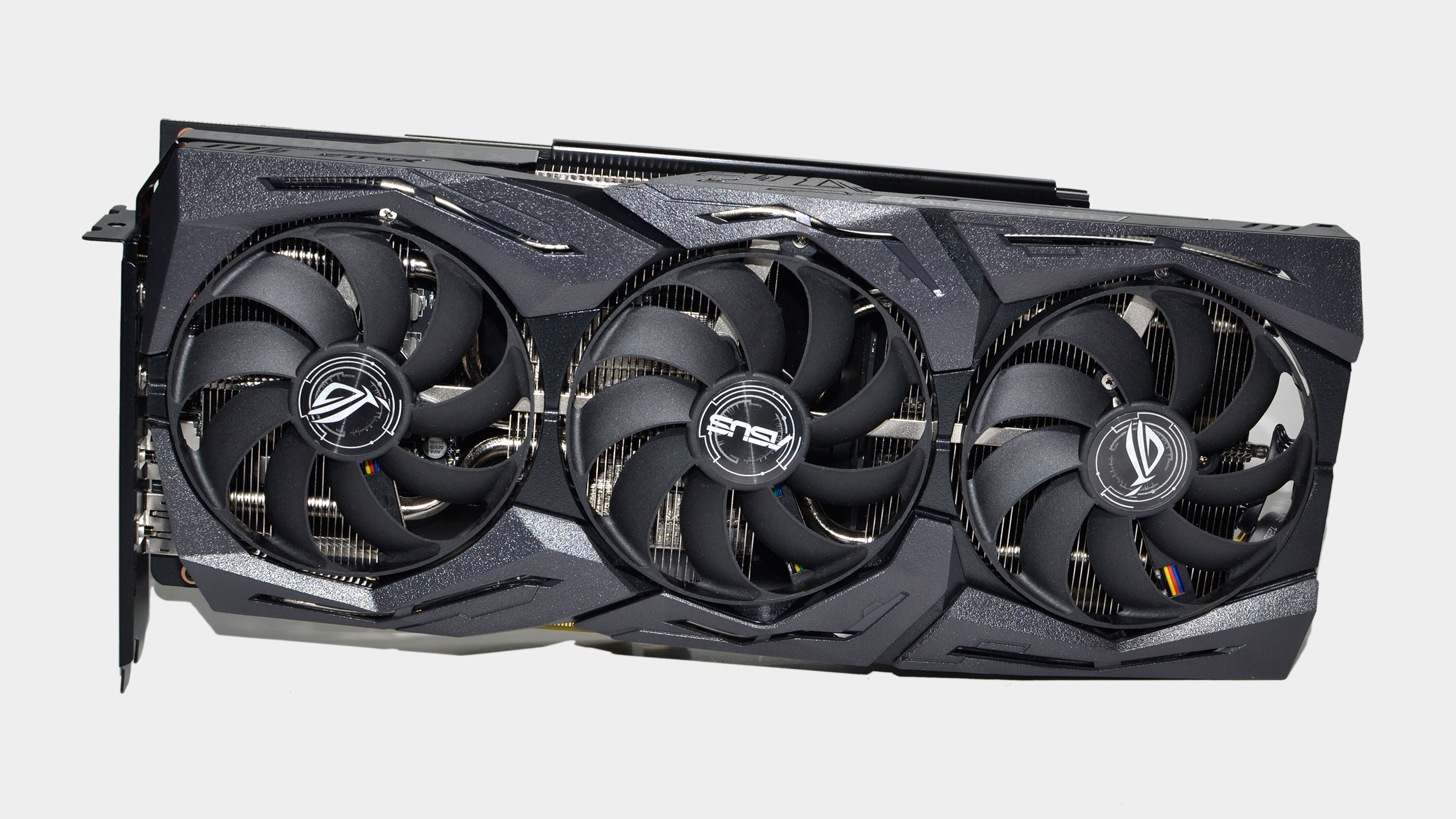
GeForce GTX 1660 Ti Performance
Ideally, I'd retest every GPU with the latest drivers each time a new card gets released, but that's not practical—it would be weeks of testing, and most of the results likely wouldn't change. I did retest everything for Nvidia's Turing launch last September, plus adding several new games since then. The new games were tested with the latest drivers available at the time, and the GTX 1660 Ti is using review drivers that carry the same 418.91 version number as the publicly available drivers.
My GPU test system uses a Core i7-8700K overclocked to 5.0GHz to help minimize CPU bottlenecks during testing, along with other high-end components. You can see the full details in the boxout on the right. For budget and midrange graphics cards, the test system is perhaps overkill, but this allows all the graphics cards to reach their full performance potential.
I've tested 19 games on 20 graphics cards for this initial review, including several new additions, at four setting/resolution combinations per game. (If you want to see results from older GPUs like the GTX 900 series and AMD's R9 cards, check out the GeForce RTX 2060 review.) Testing is conducted at 1080p 'medium' quality, along with 'ultra' quality at 1080p, 1440p, and 4k. In most games the ultra preset maxes out all the options, while in games that don't include presets I've manually maxed out the settings (eg, GTA5's advanced graphics menu, other than superscaling). Some games punish cards with less than 6GB or even 8GB of VRAM at these settings, but in general the GTX 1660 Ti should be fine.

Swipe left/right for additional charts

Swipe left/right for additional charts
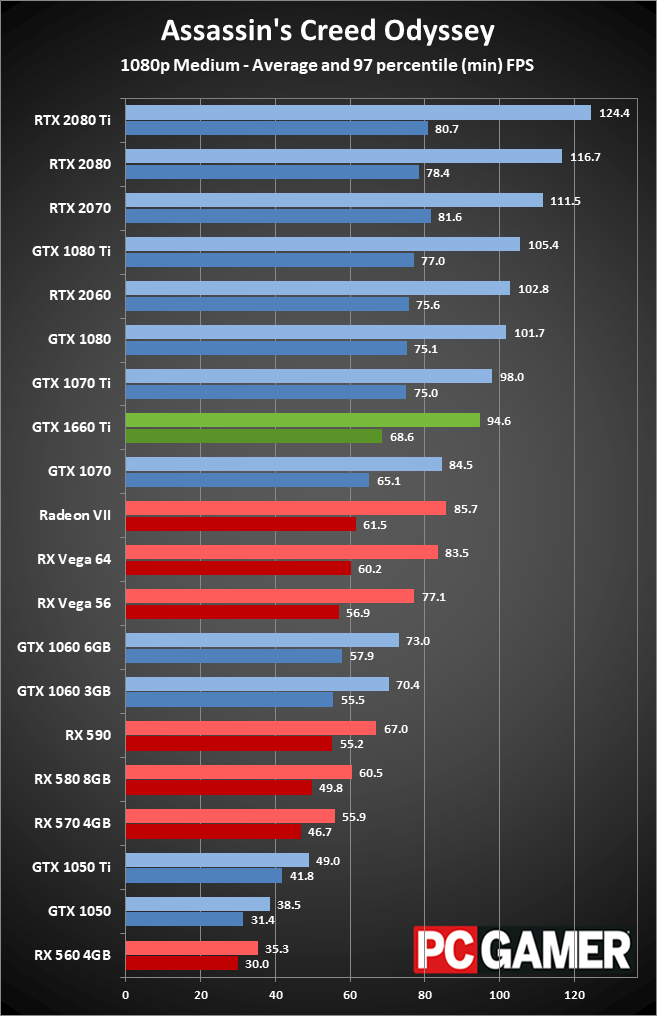
Swipe left/right for additional charts

Swipe left/right for additional charts
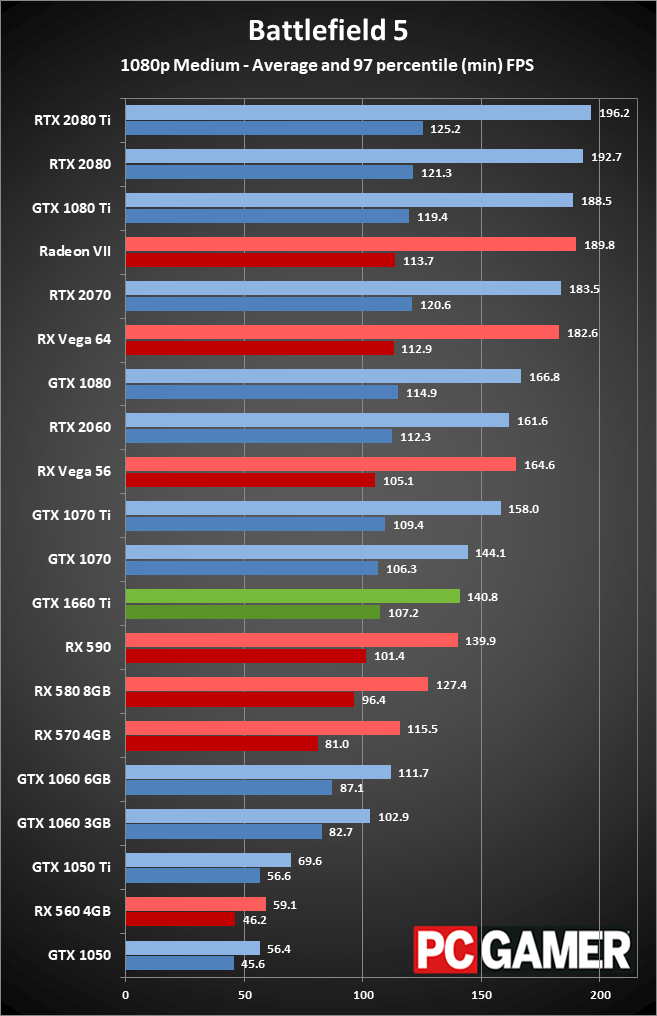
Swipe left/right for additional charts

Swipe left/right for additional charts
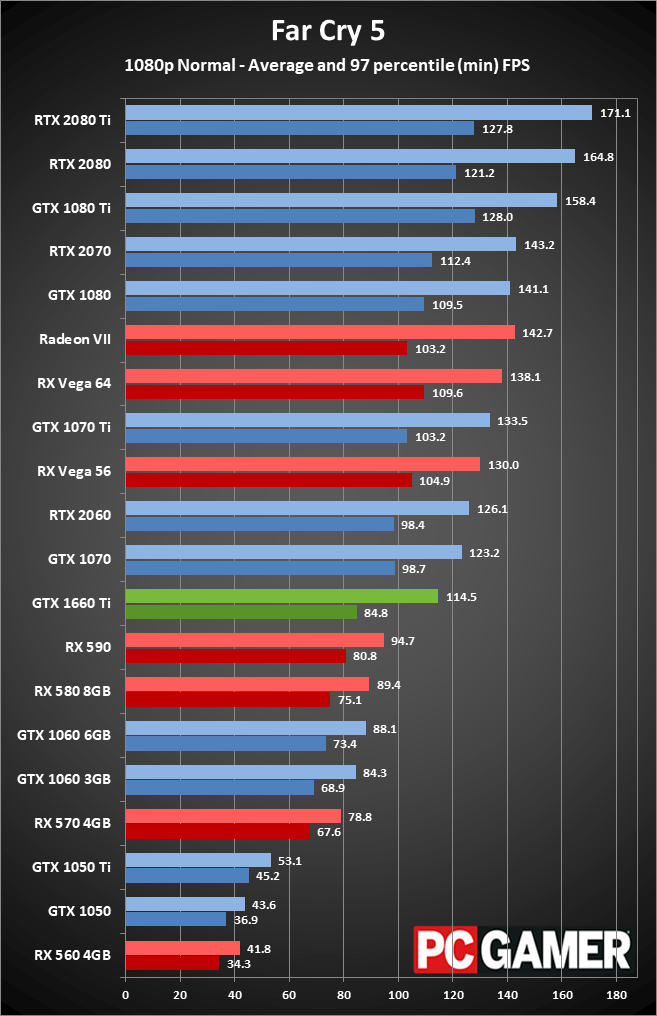
Swipe left/right for additional charts
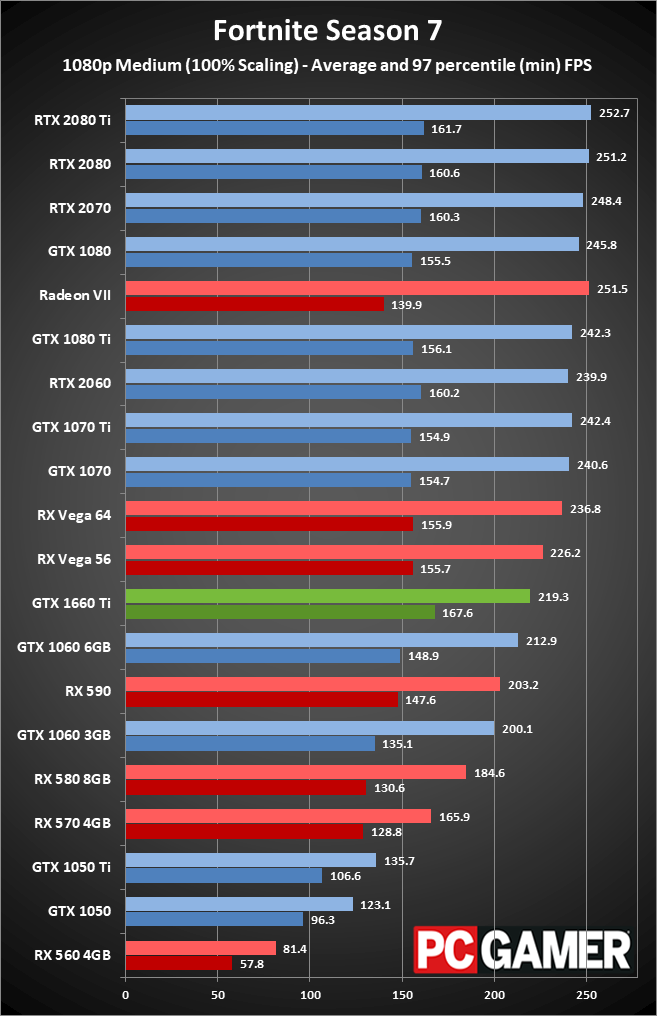
Swipe left/right for additional charts

Swipe left/right for additional charts
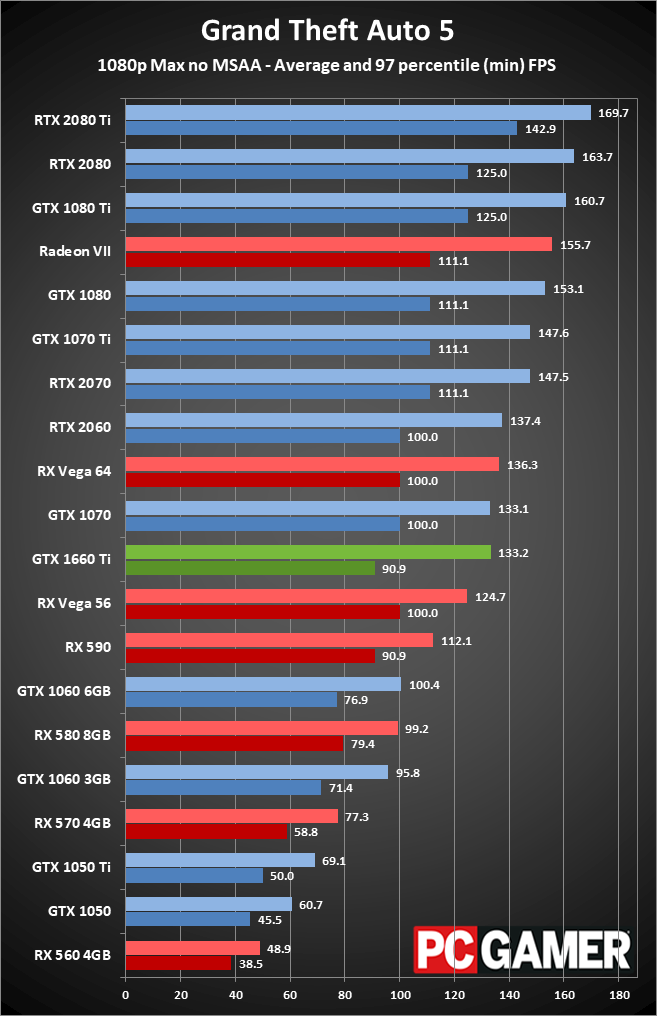
Swipe left/right for additional charts

Swipe left/right for additional charts

Swipe left/right for additional charts

Swipe left/right for additional charts
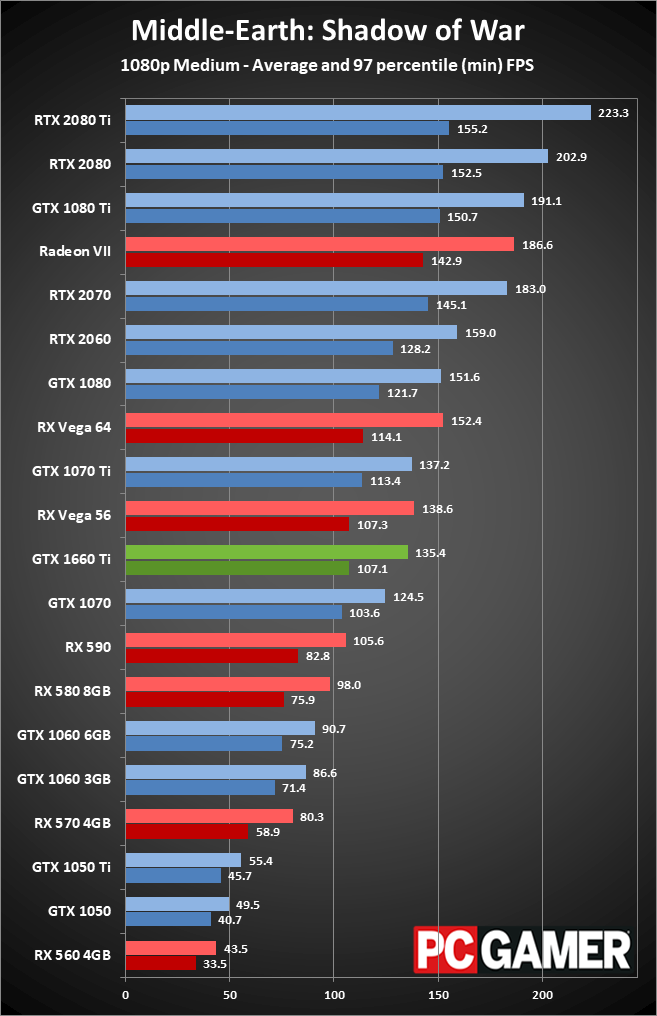
Swipe left/right for additional charts
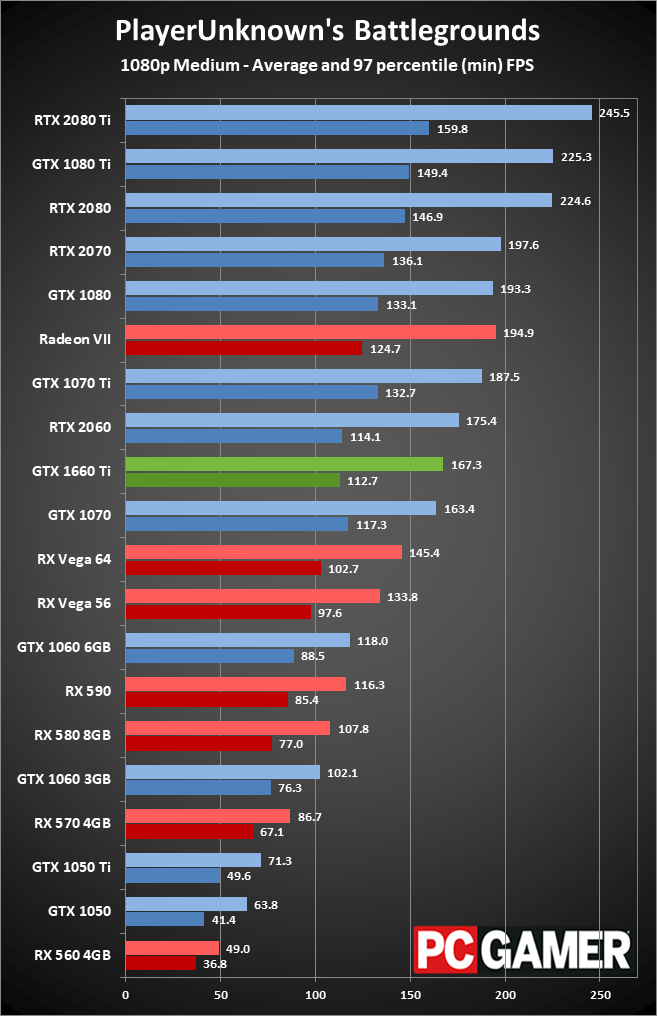
Swipe left/right for additional charts
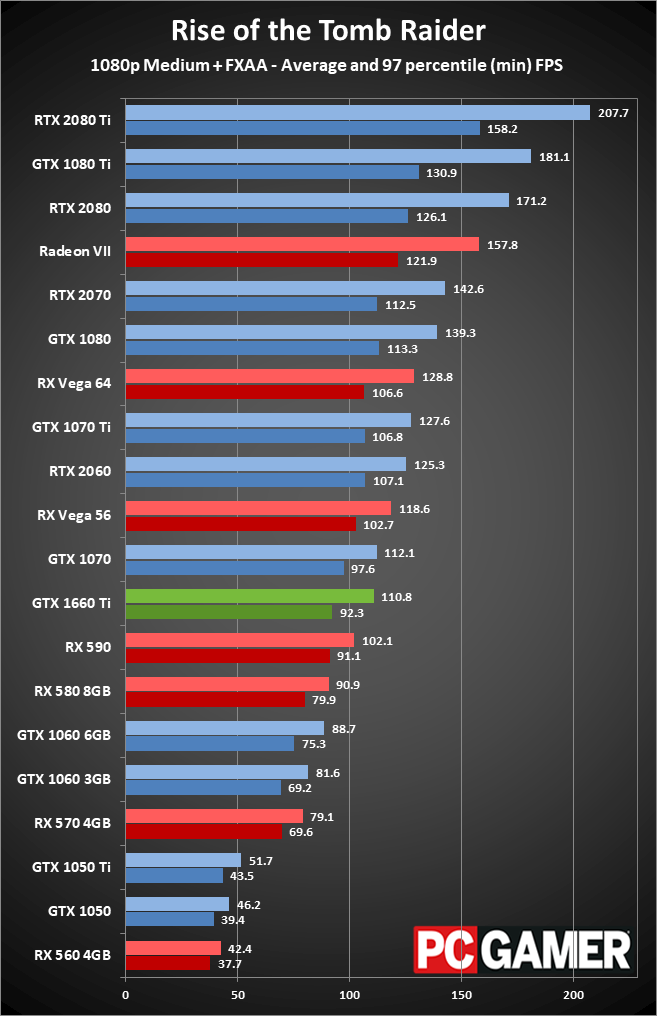
Swipe left/right for additional charts
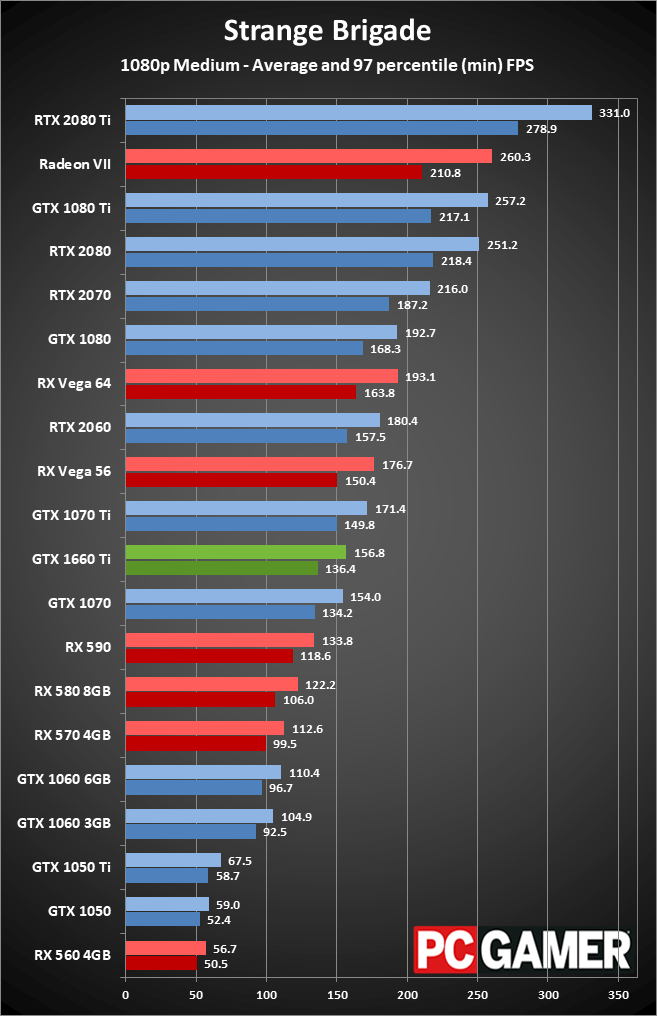
Swipe left/right for additional charts
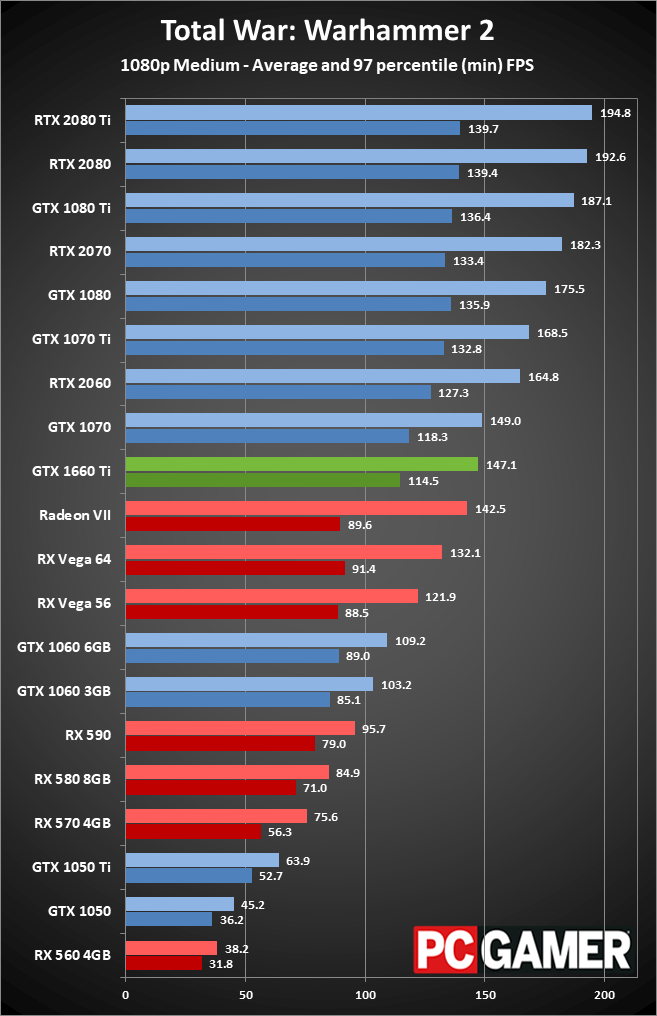
Swipe left/right for additional charts

Swipe left/right for additional charts

Swipe left/right for additional charts

Swipe left/right for additional charts
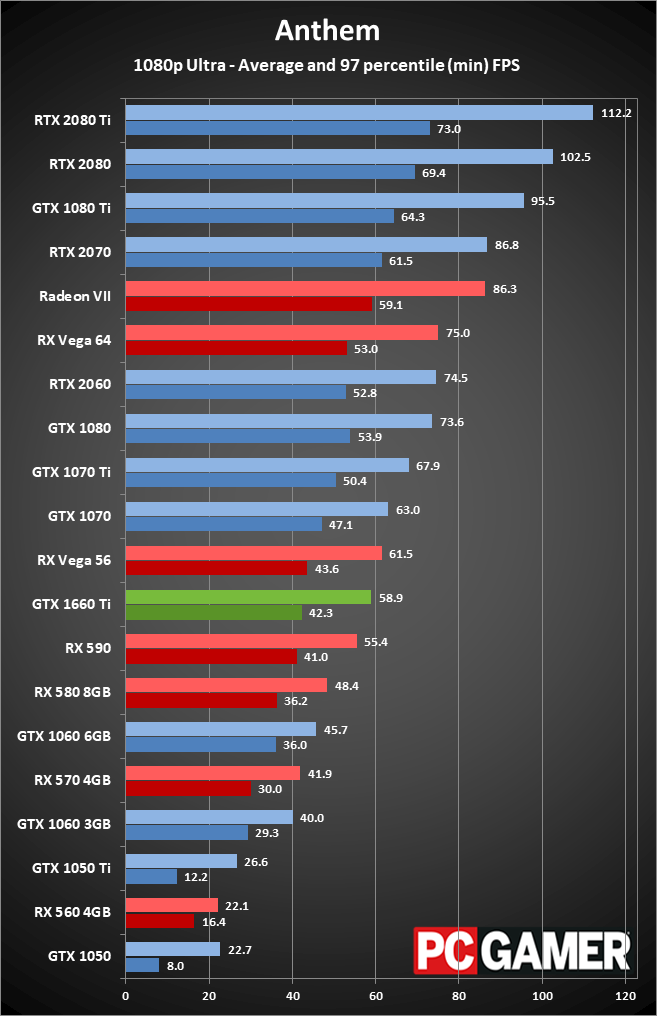
Swipe left/right for additional charts

Swipe left/right for additional charts
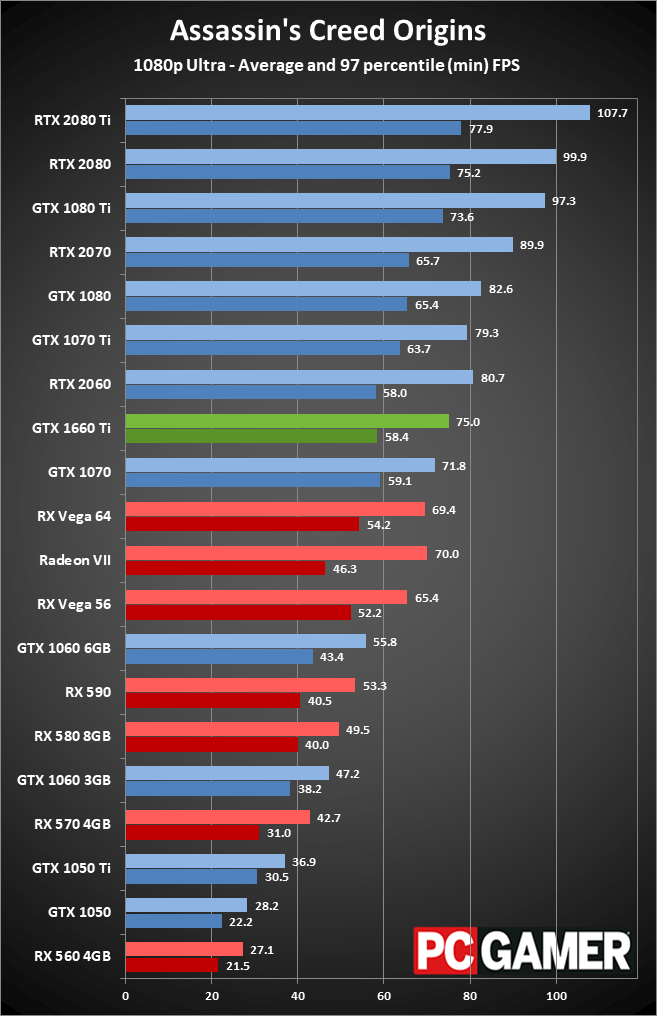
Swipe left/right for additional charts
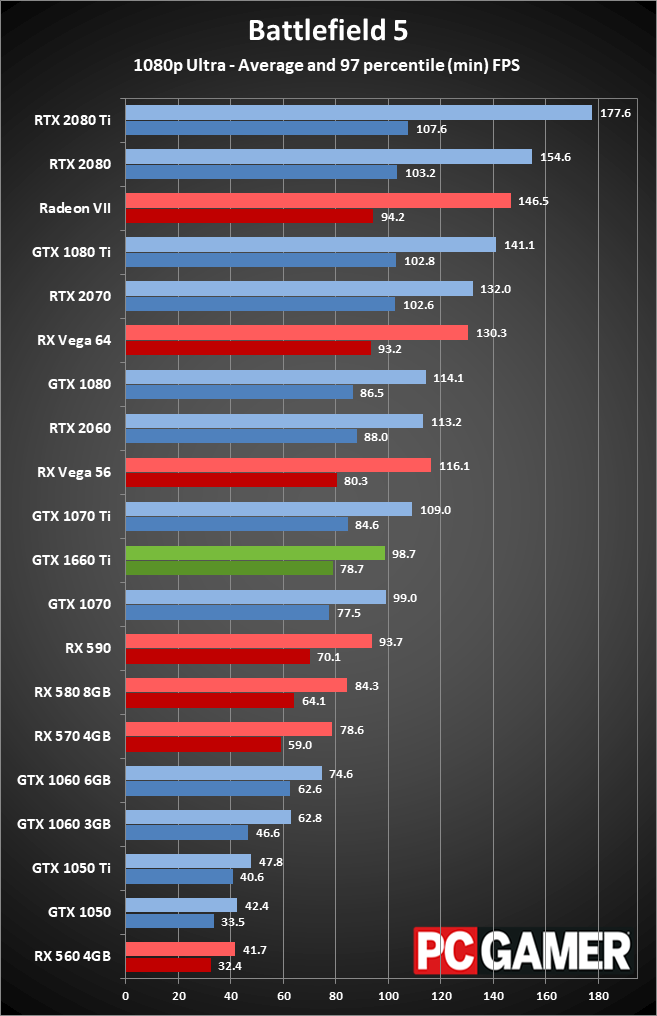
Swipe left/right for additional charts
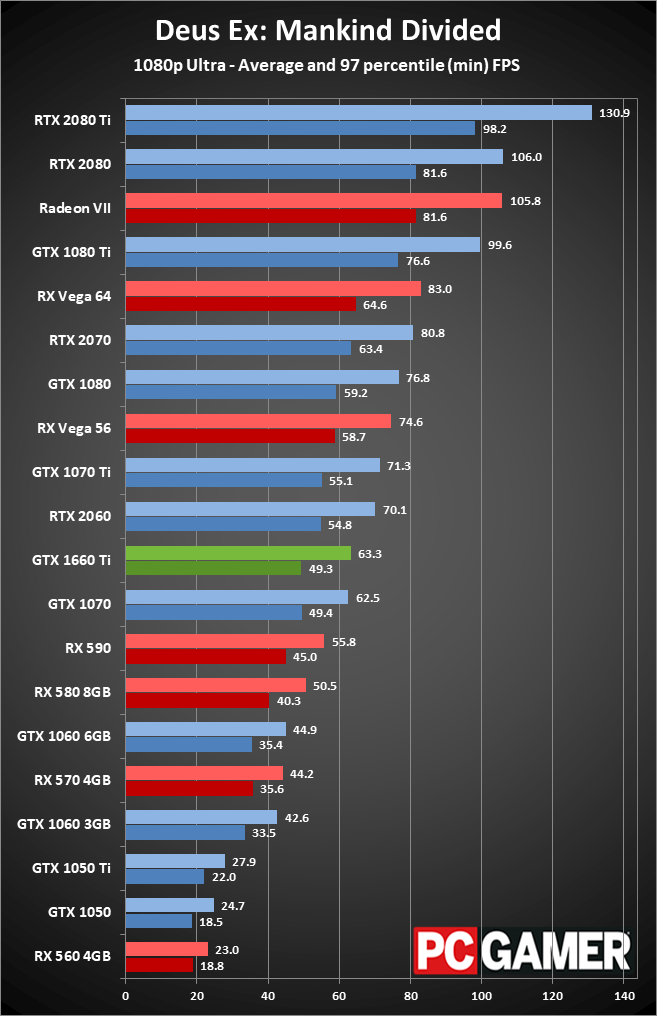
Swipe left/right for additional charts

Swipe left/right for additional charts
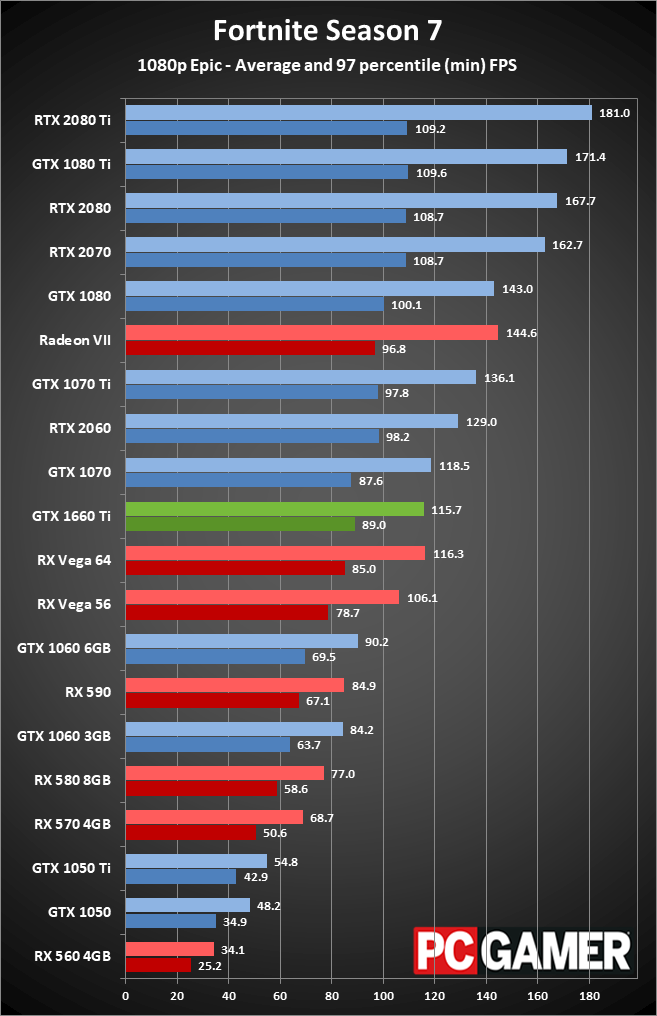
Swipe left/right for additional charts
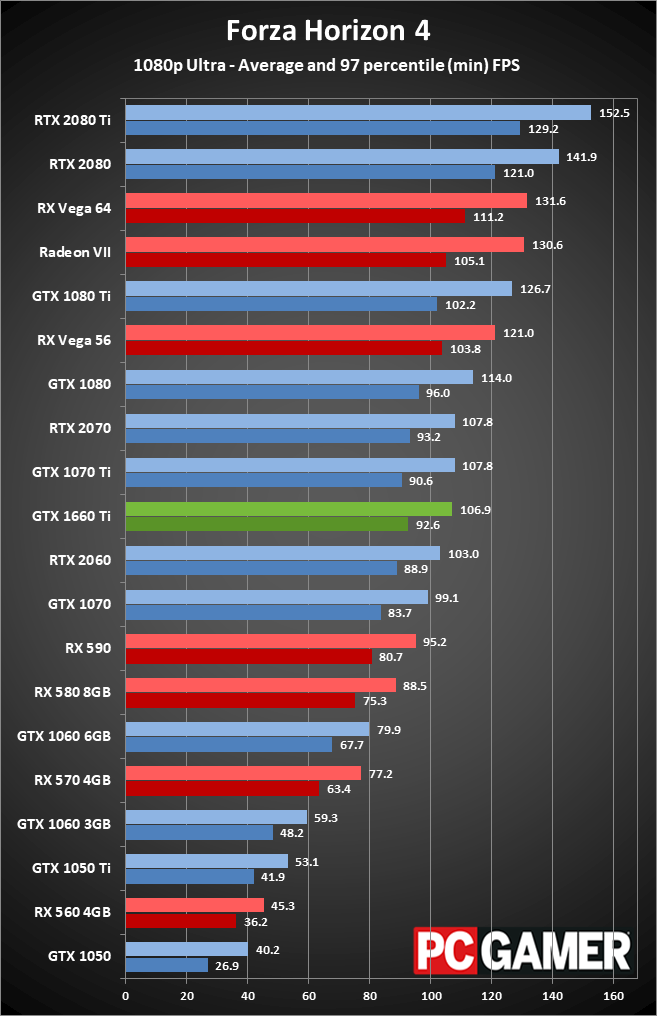
Swipe left/right for additional charts

Swipe left/right for additional charts
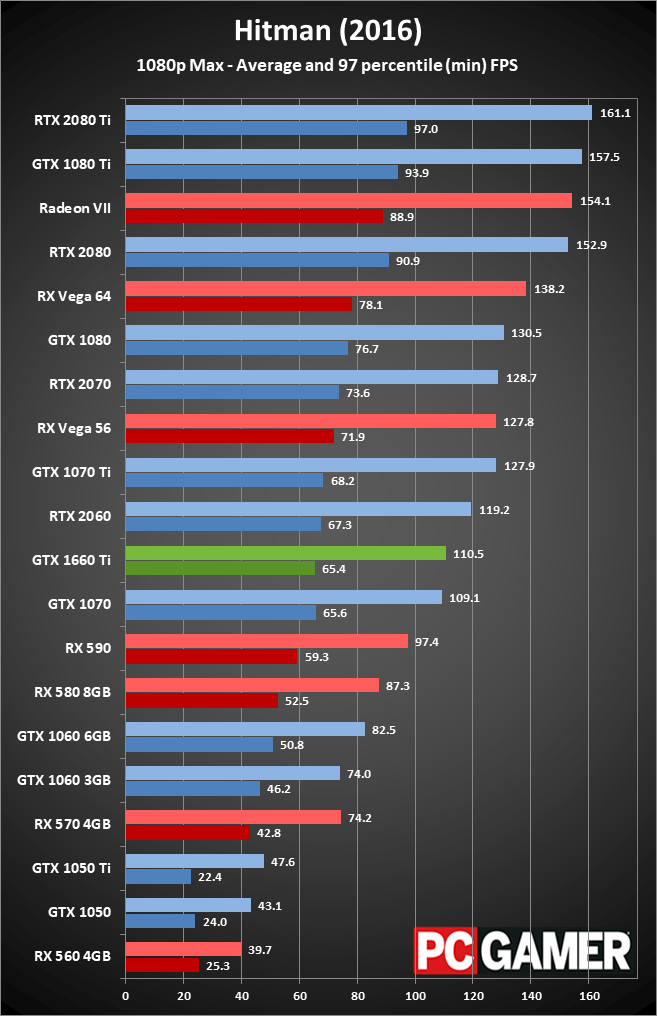
Swipe left/right for additional charts
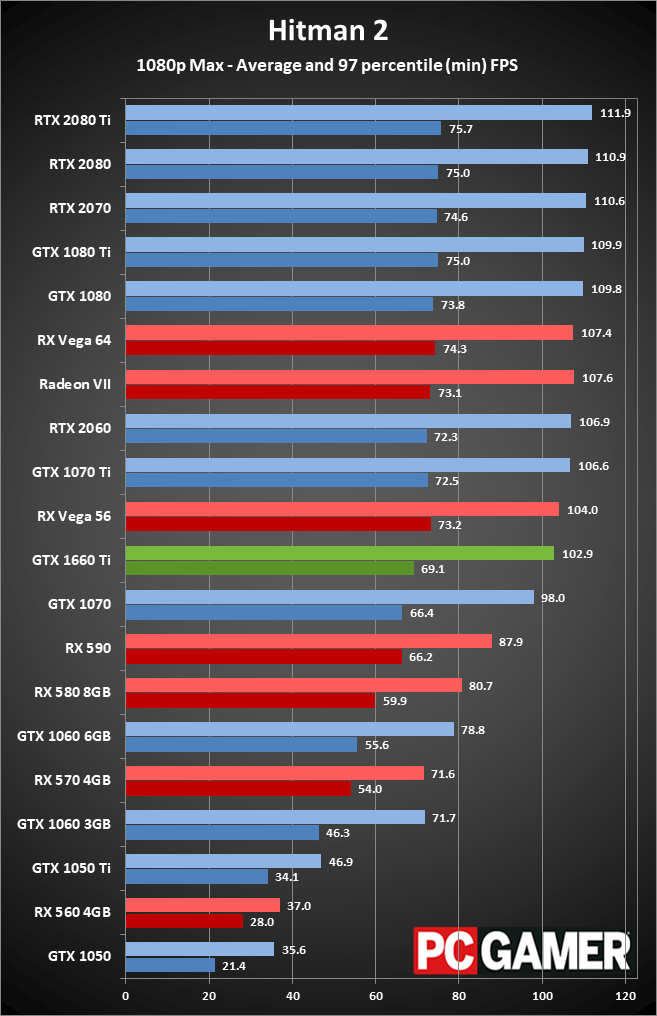
Swipe left/right for additional charts
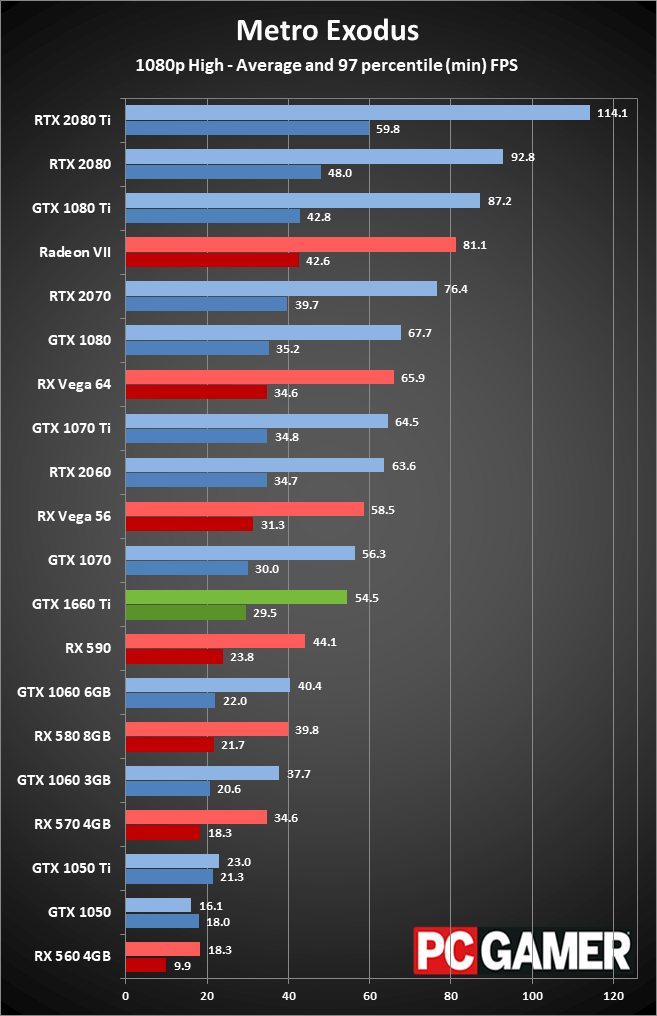
Swipe left/right for additional charts

Swipe left/right for additional charts
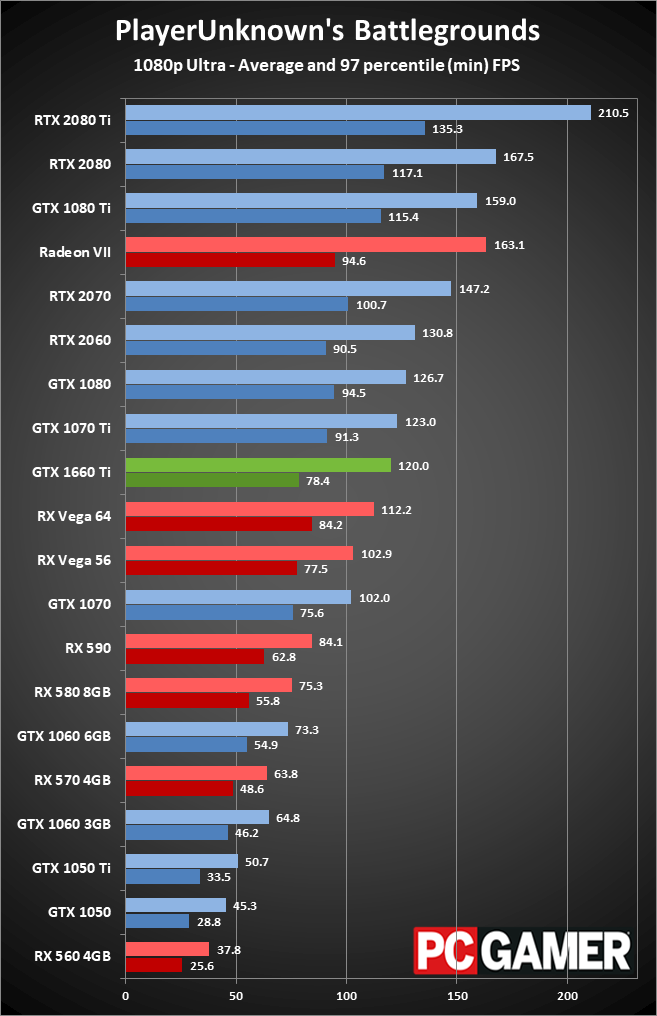
Swipe left/right for additional charts

Swipe left/right for additional charts

Swipe left/right for additional charts
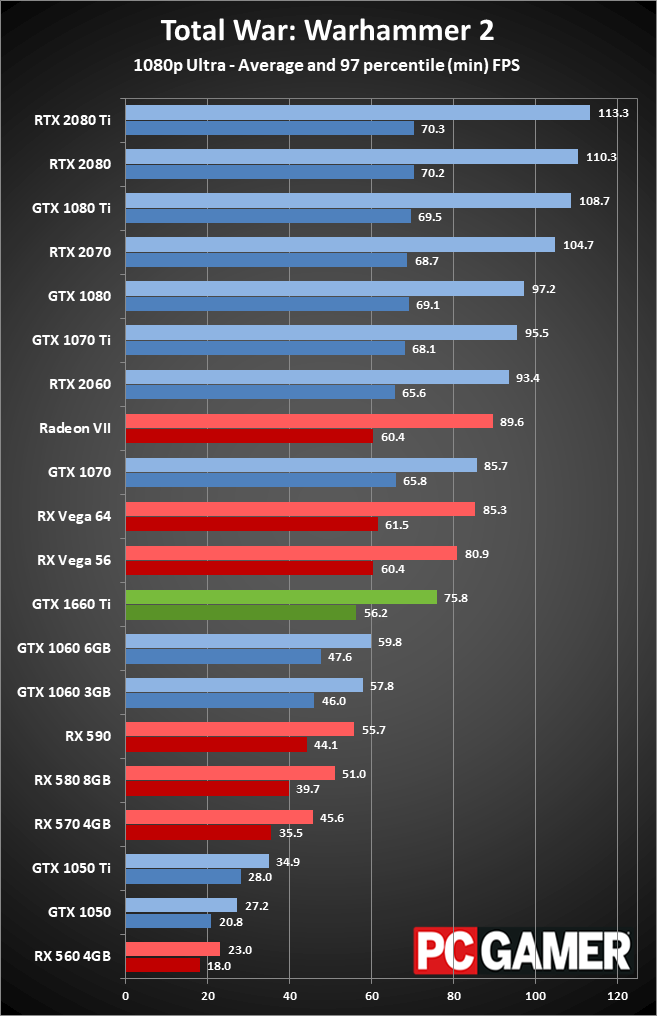
Swipe left/right for additional charts
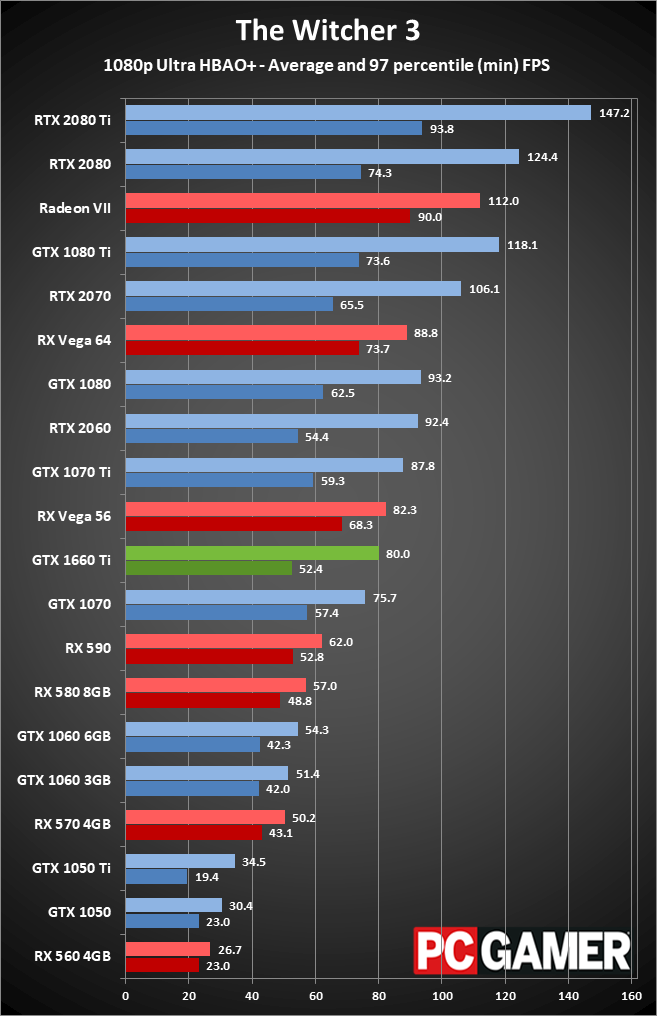
Swipe left/right for additional charts

Swipe left/right for additional charts
While some will argue about whether or not $279 is a mainstream price, the GTX 1660 Ti is a card that targets 1080p gamers. That's still most people (60 percent), going by the latest Steam Hardware Survey, even though 1440p displays have largely replaced 1080p as our recommendation for the best gaming monitors. And the news is good: at 1080p, the GTX 1660 Ti zips along and averages well above 60fps in most games.
Where does it come up short? Not surprisingly, it's the most demanding games: Anthem, Assassin's Creed Odyssey, and Metro Exodus can't quite maintain a steady 60fps at 1080p ultra—actually, Metro can't even do that at the high preset, but that's a story I discuss in more detail in my Metro performance analysis. You'll want to drop settings down a notch or two in such cases, but at 1080p medium there's still plenty of headroom left.
As far as the competition is concerned, the GTX 1660 Ti takes on AMD's RX 590 and wins decisively, averaging a 20-25 percent lead. There are no games where AMD's similarly priced card comes out ahead, though it does at least come close in a few games (Anthem, Battlefield 5, and Strange Brigade). Perhaps more importantly is how the GTX 1660 Ti fares against older GPUs. It's about 35 percent faster than the GTX 1060 6GB, and it even comes in just a hair ahead of the GTX 1070—though there are definitely games where the 1070 wins. If you already own a 1070, obviously this isn't the card for you, but it's also priced about $75 lower than the current prices of the outgoing card. Then again, we're talking about a card that's two and a half years old, so the savings over time really aren't that great.
If you're sitting on an older GPU like a GTX 970, it can make more sense to upgrade. Performance is 75 percent better at 1080p ultra, as well as 55 faster at 1080 medium. That's a graphics card that's now 4.5 years old, and of course anything slower than a 970 would see even bigger gains. Compared to AMD's R9 390 (or the similar performing R9 290X that's over five years old now), the 1660 Ti is 65 percent faster, and it does that while cutting the graphics card power use in half. Still, it would be a much more noticeable upgrade if you're running something like an HD 7970 / R9 280X or lower.
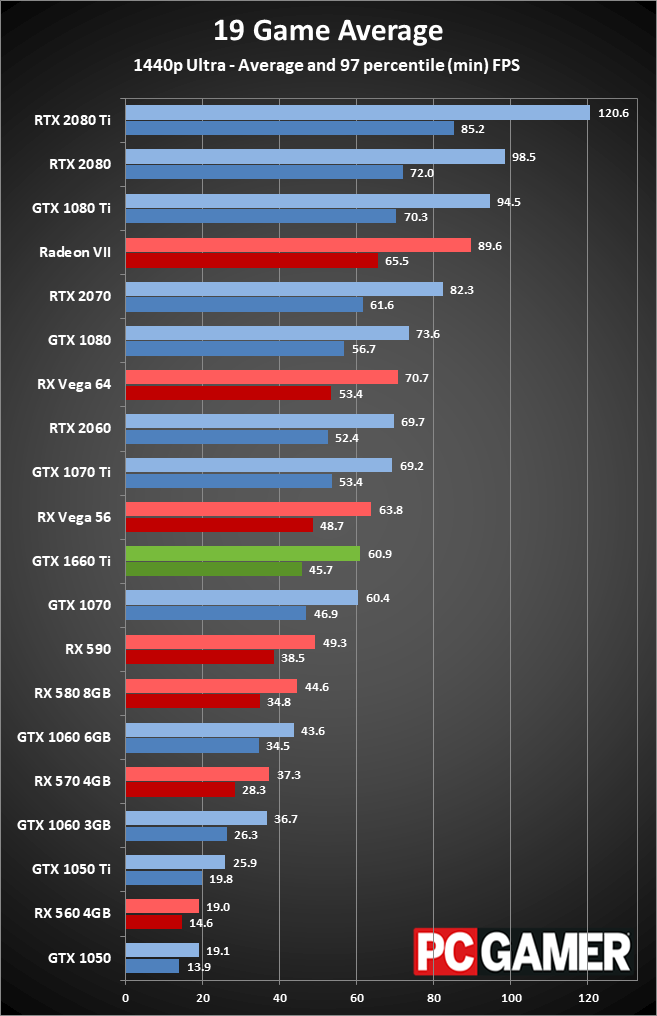
Swipe left/right for additional charts
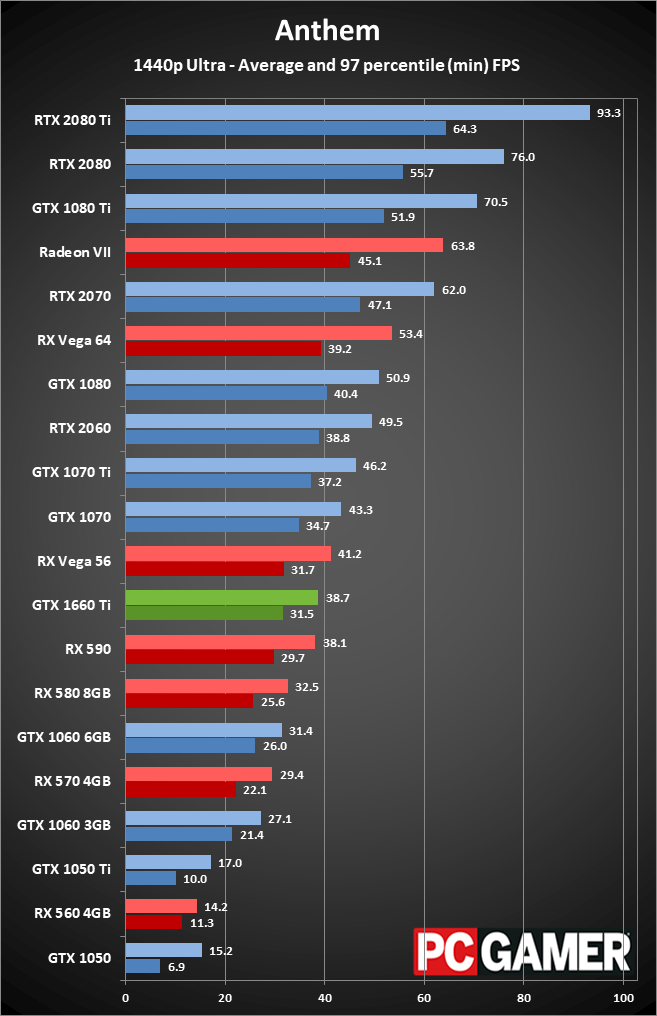
Swipe left/right for additional charts
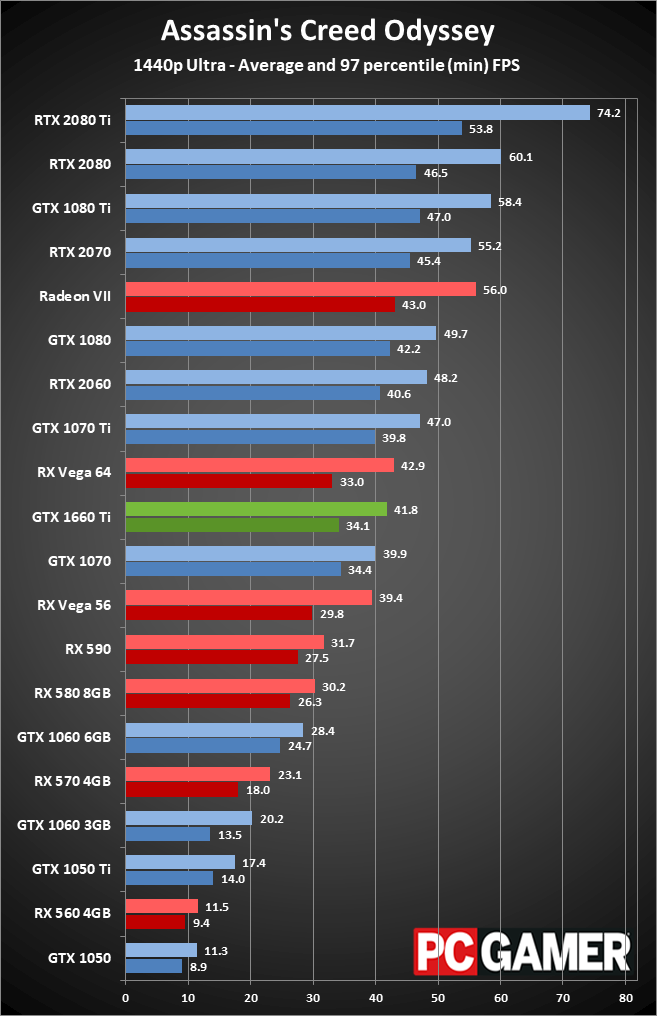
Swipe left/right for additional charts
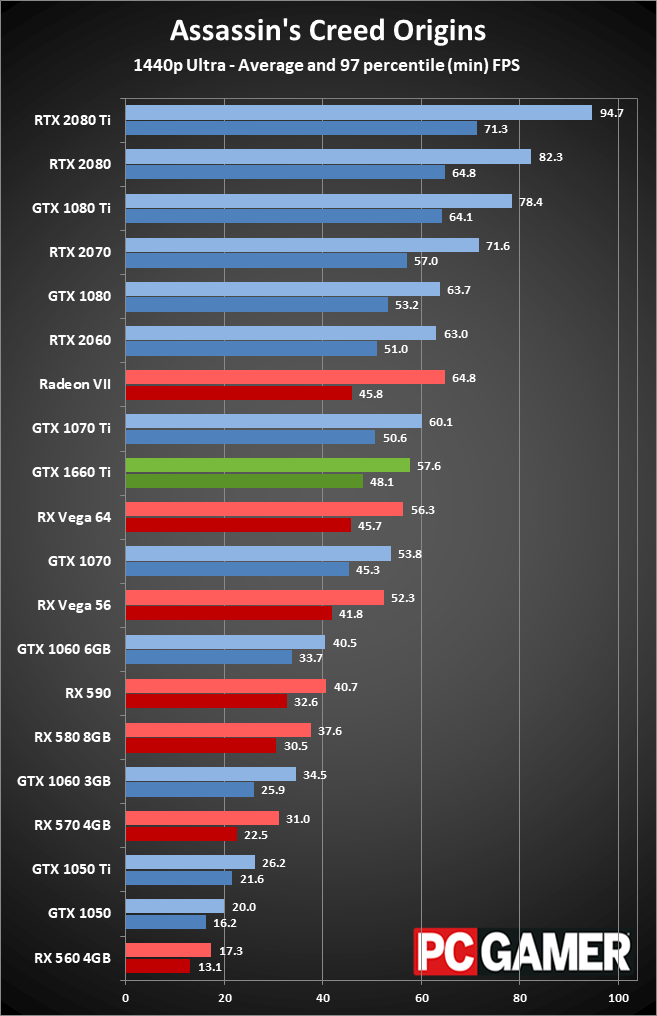
Swipe left/right for additional charts
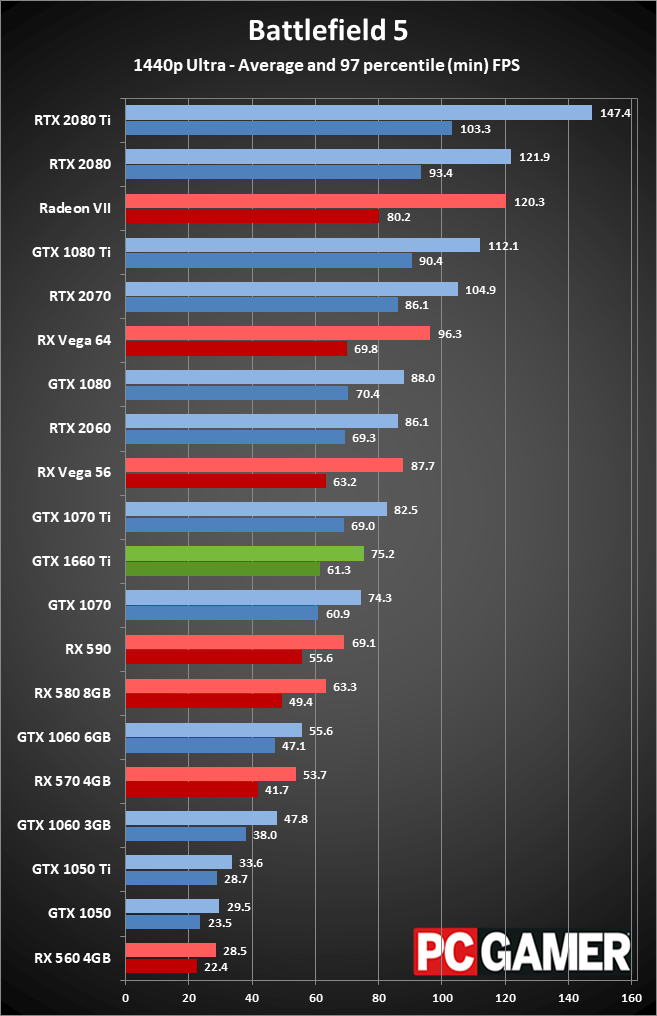
Swipe left/right for additional charts
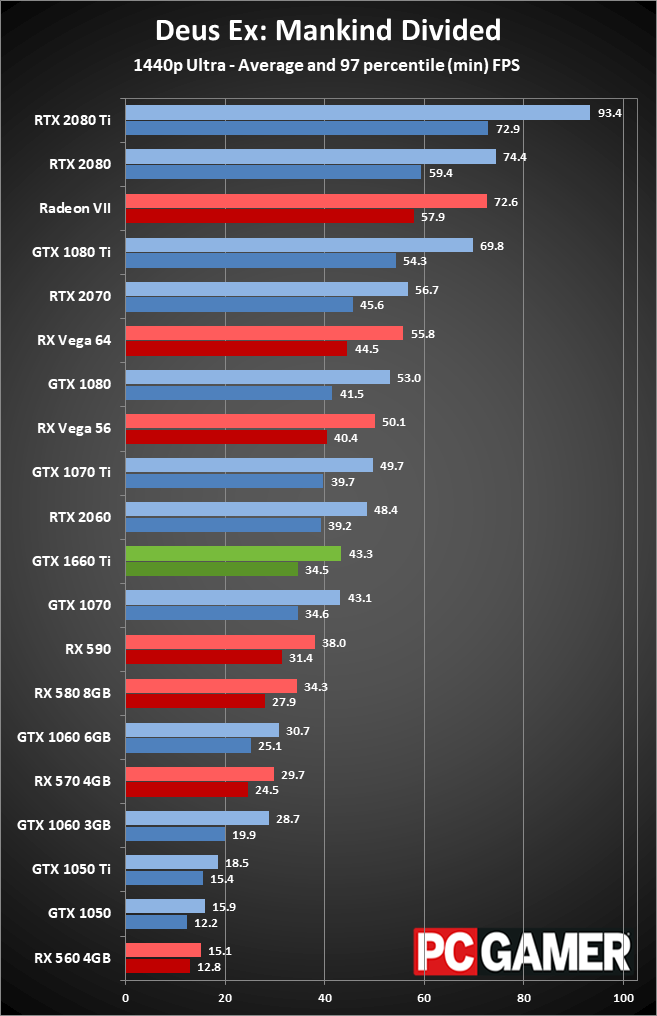
Swipe left/right for additional charts
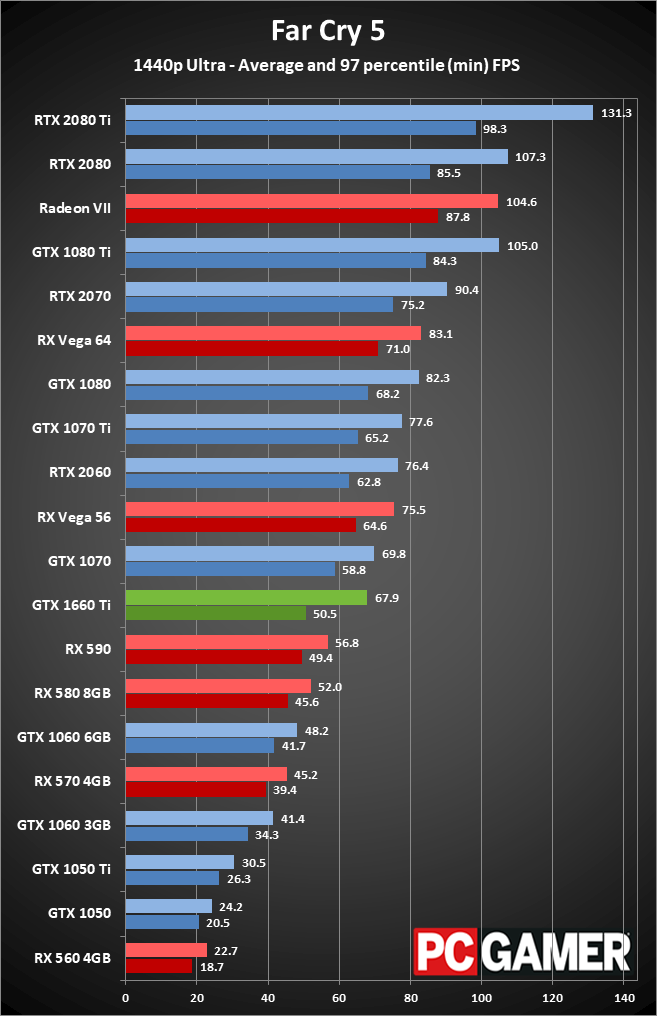
Swipe left/right for additional charts

Swipe left/right for additional charts
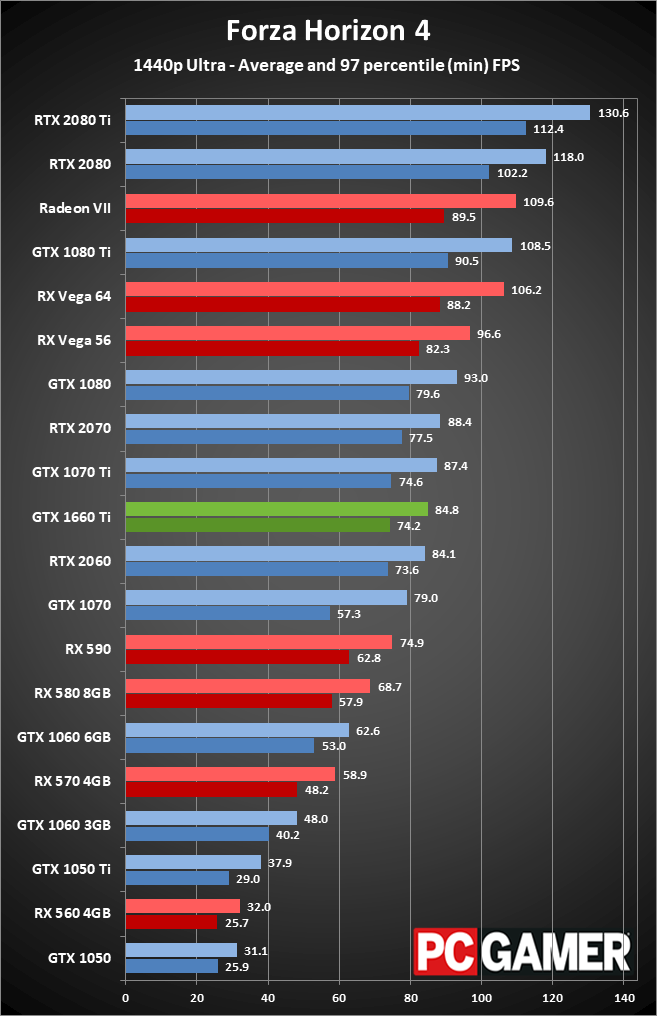
Swipe left/right for additional charts
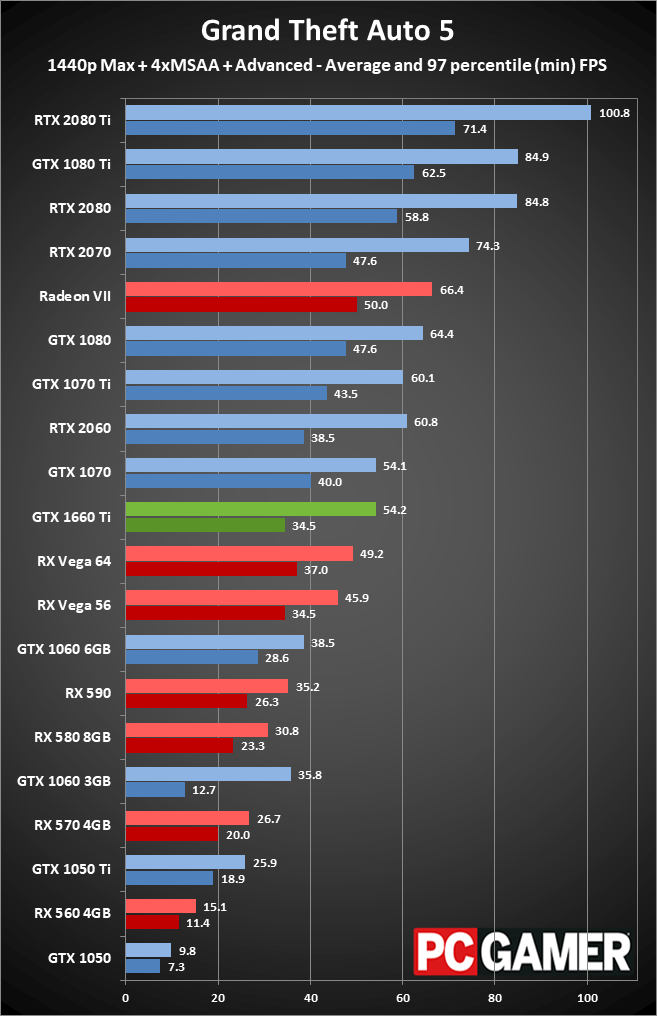
Swipe left/right for additional charts
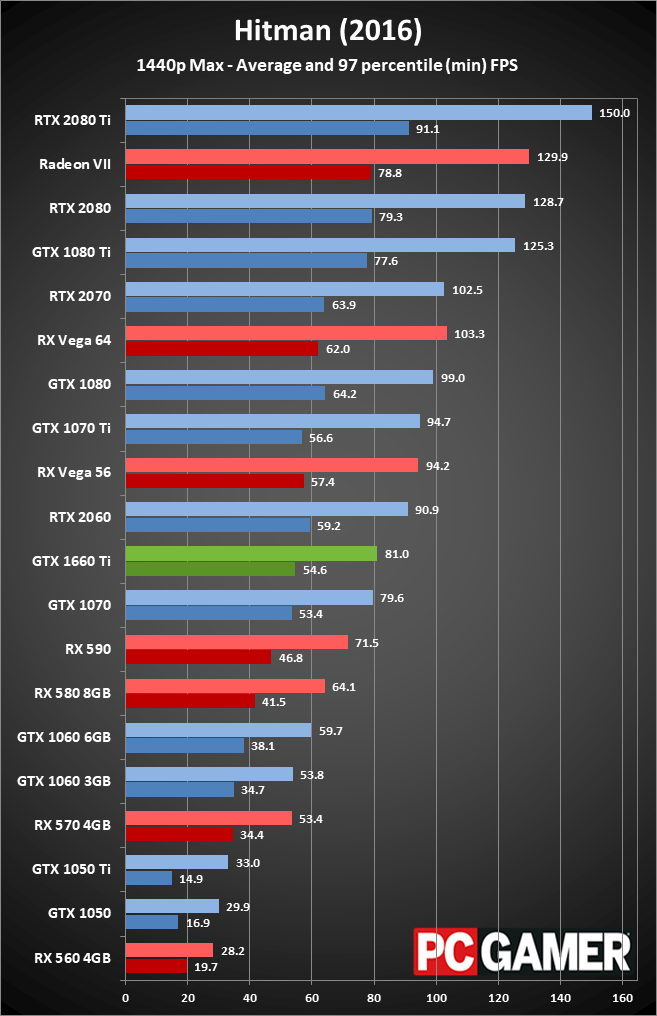
Swipe left/right for additional charts
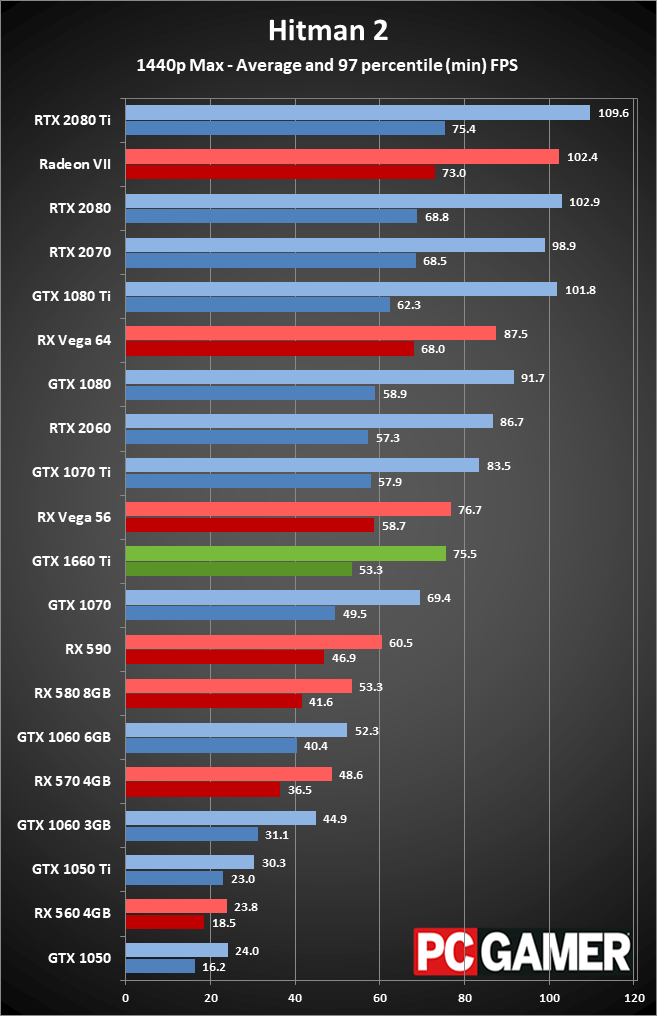
Swipe left/right for additional charts
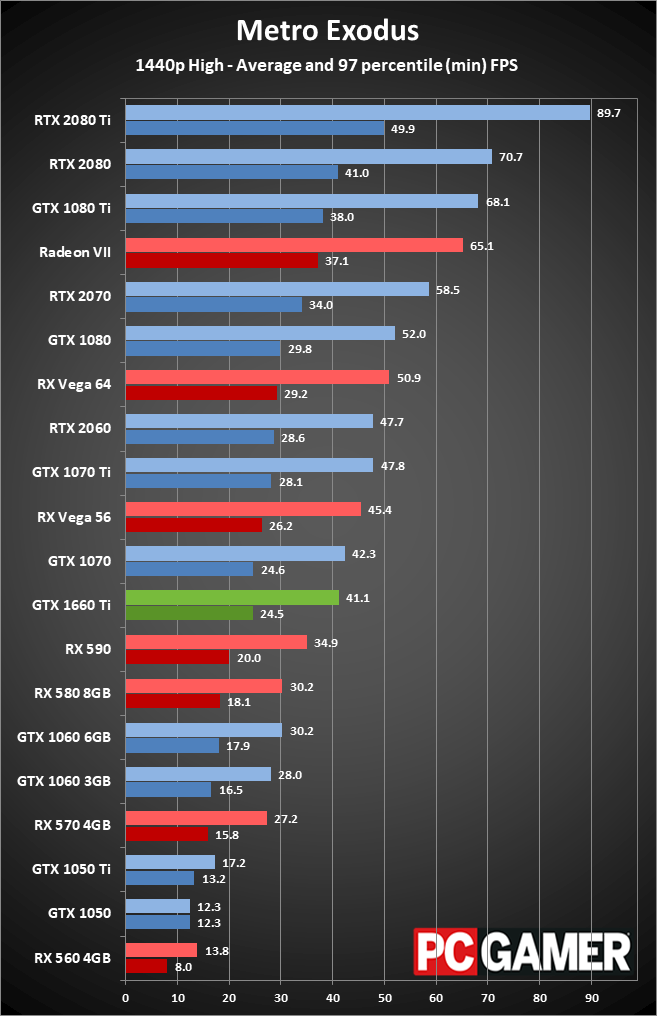
Swipe left/right for additional charts
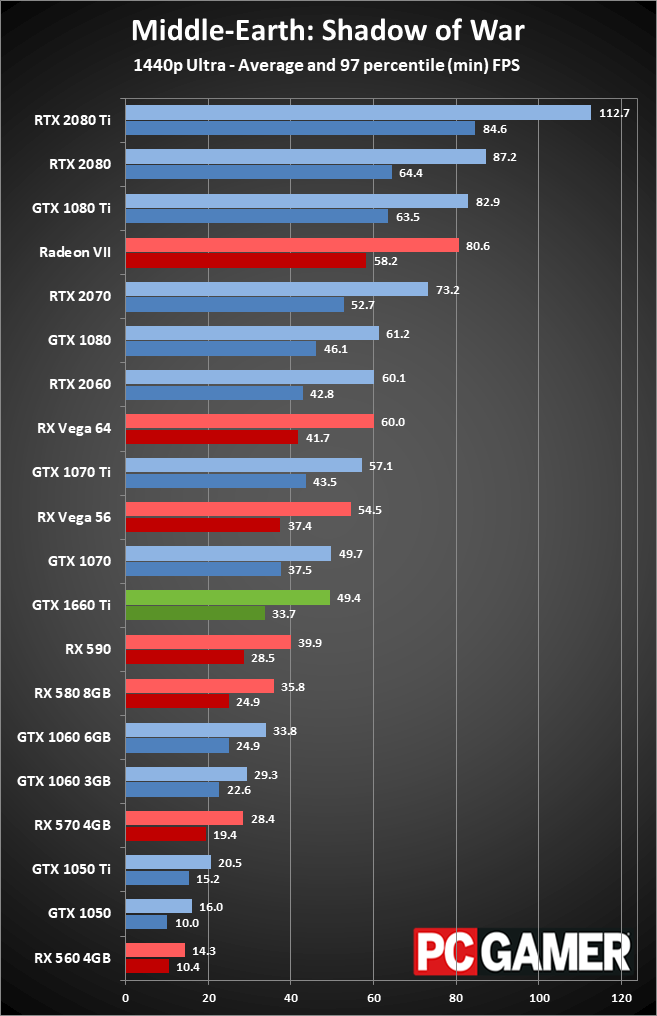
Swipe left/right for additional charts
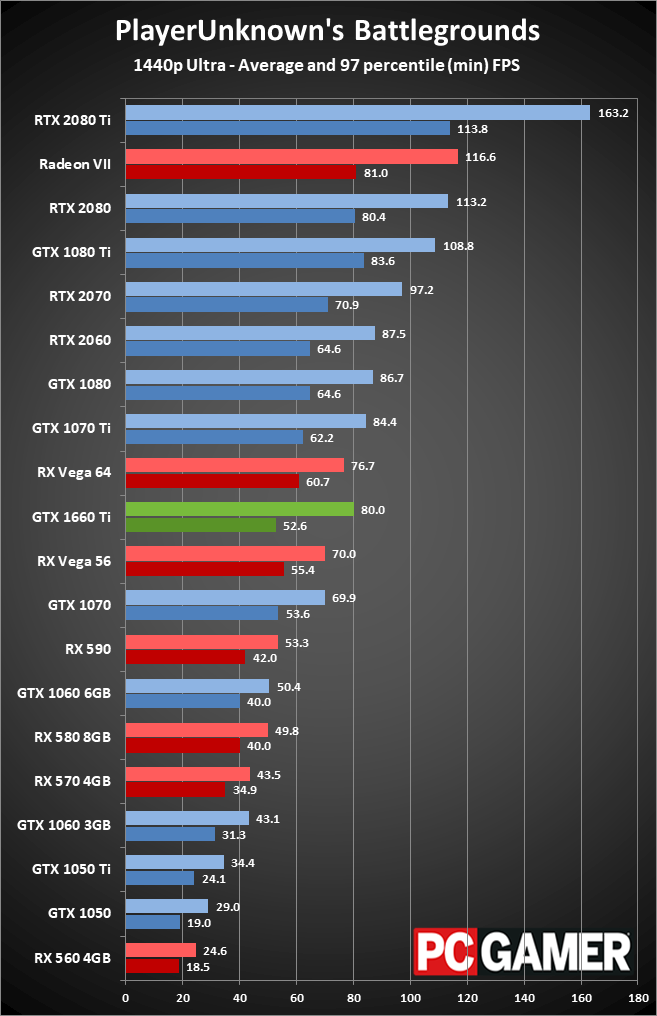
Swipe left/right for additional charts
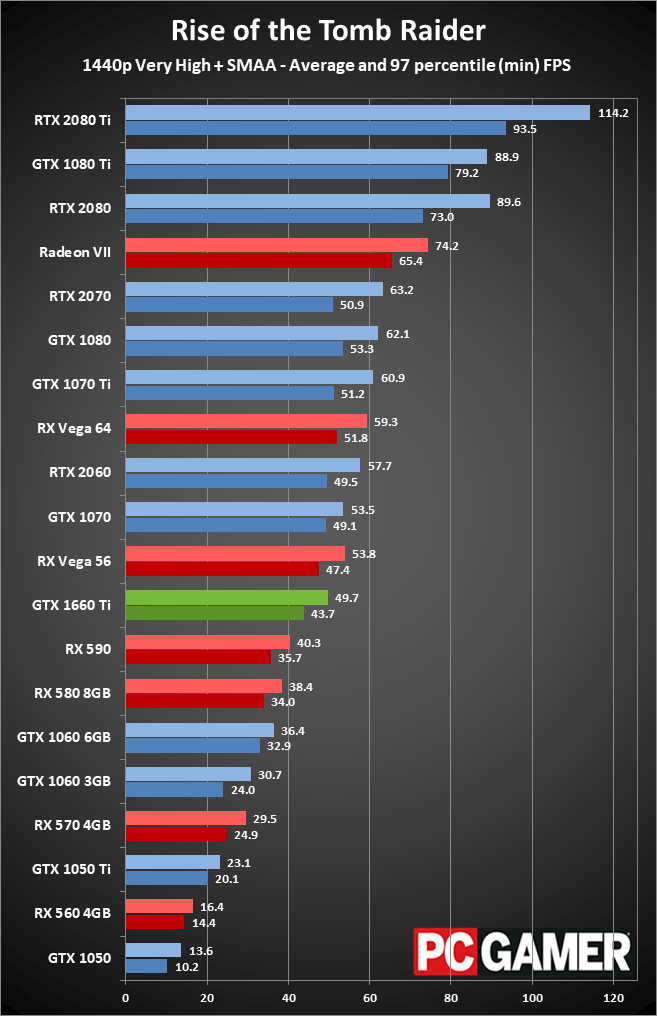
Swipe left/right for additional charts

Swipe left/right for additional charts

Swipe left/right for additional charts
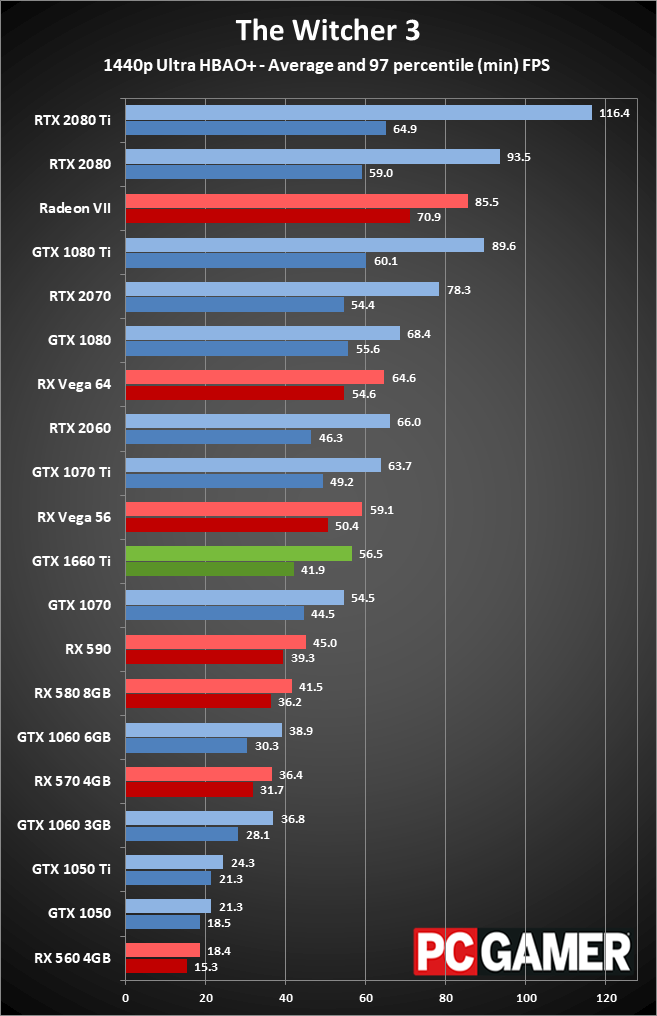
Swipe left/right for additional charts
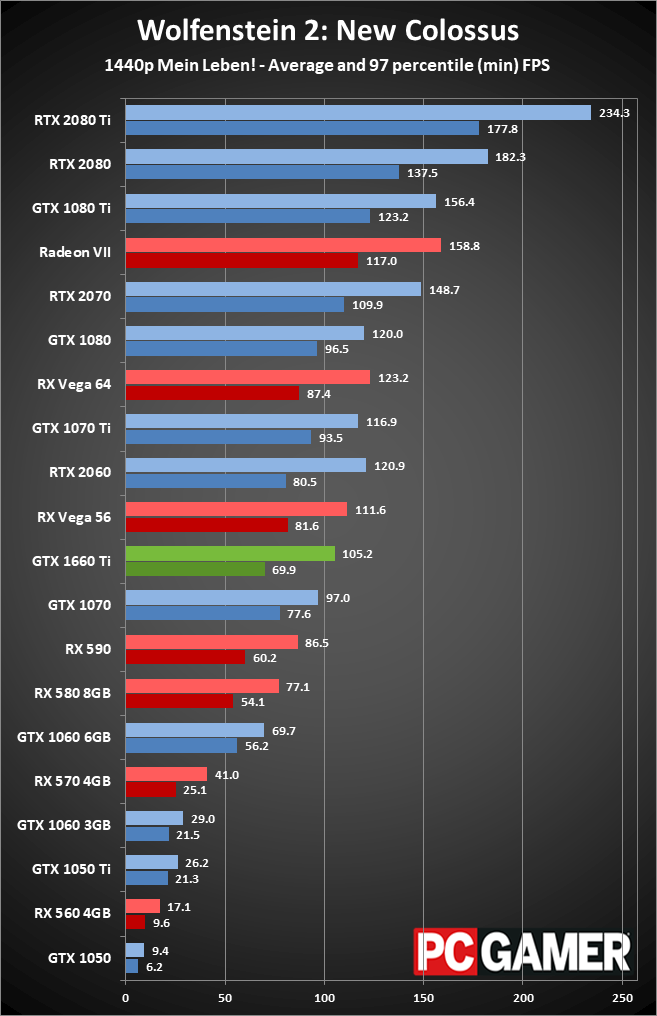
Swipe left/right for additional charts
1440p ultra is often a bit much for midrange GPUs like the GTX 1660 Ti and other sub-$300 graphics cards. It's viable in some games but not in others, though dropping the quality a notch or two certainly helps. Average framerates at 1440p ultra are 62fps, basically tied with the GTX 1070, though of course the Asus 1660 Ti comes with a decent overclock. (A reference model would be 5-10 percent slower.)
Neither card will hit a steady 60fps, though. About half of the games I tested average 60fps or more, sometimes much more, while the other half fall below—with a few like Anthem, Assassin's Creed Odyssey, Deus Ex, and Metro Exodus sitting closer to 40fps.
Nvidia's newcomer beats AMD's mainstream RX 590 by about 25 percent as well, for roughly the same price while using less power. It's also 80 percent faster than a GTX 970, but only 60 percent faster than the R9 390 as the 8GB VRAM helps AMD's old Fiji card at this resolution.

Swipe left/right for additional charts
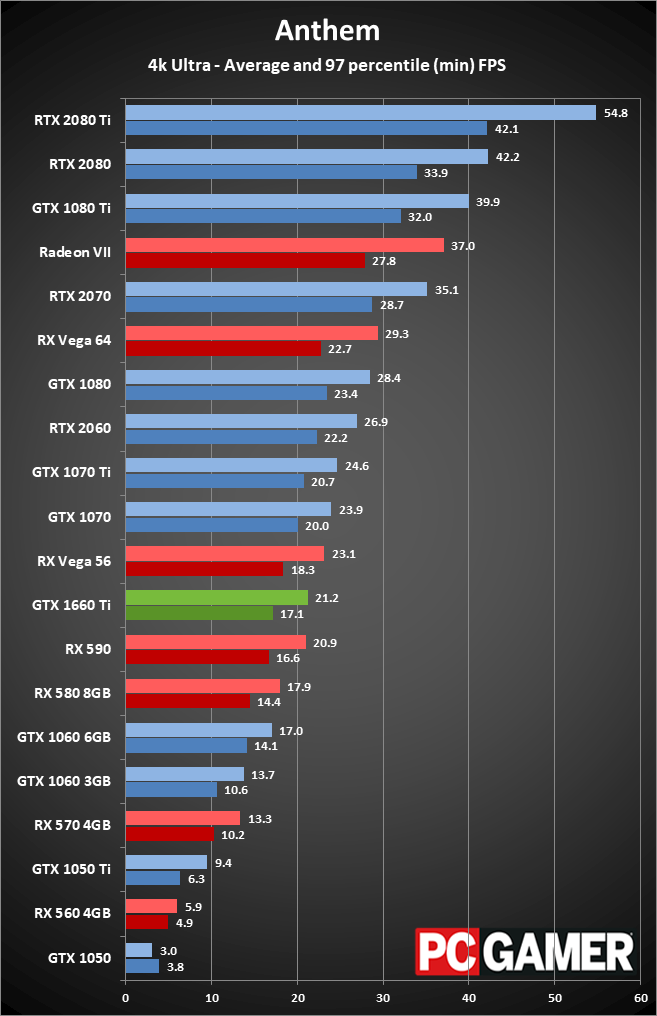
Swipe left/right for additional charts
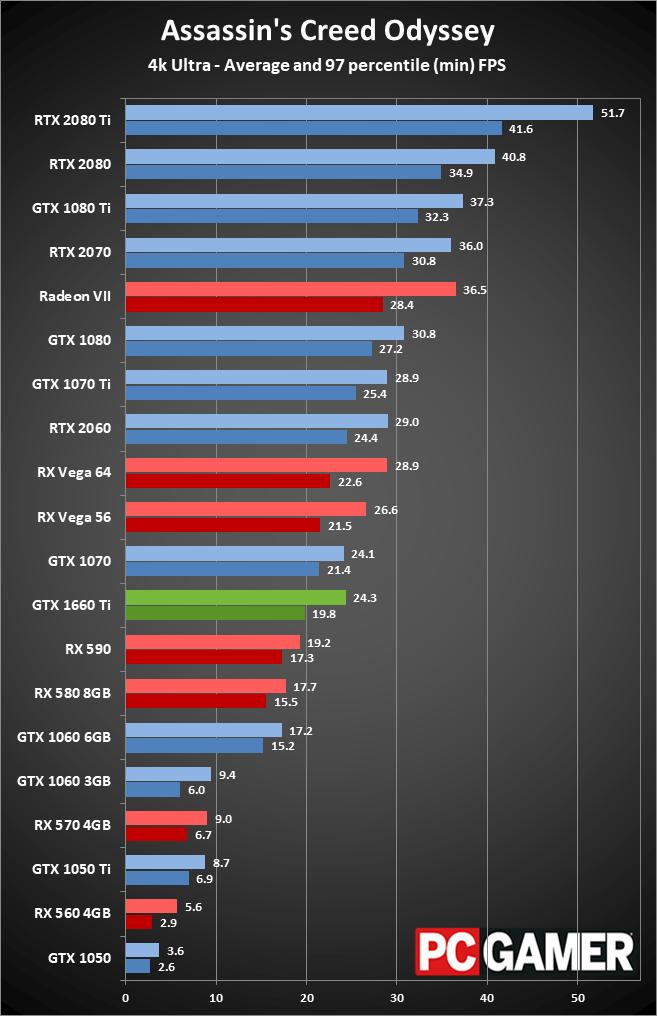
Swipe left/right for additional charts

Swipe left/right for additional charts

Swipe left/right for additional charts
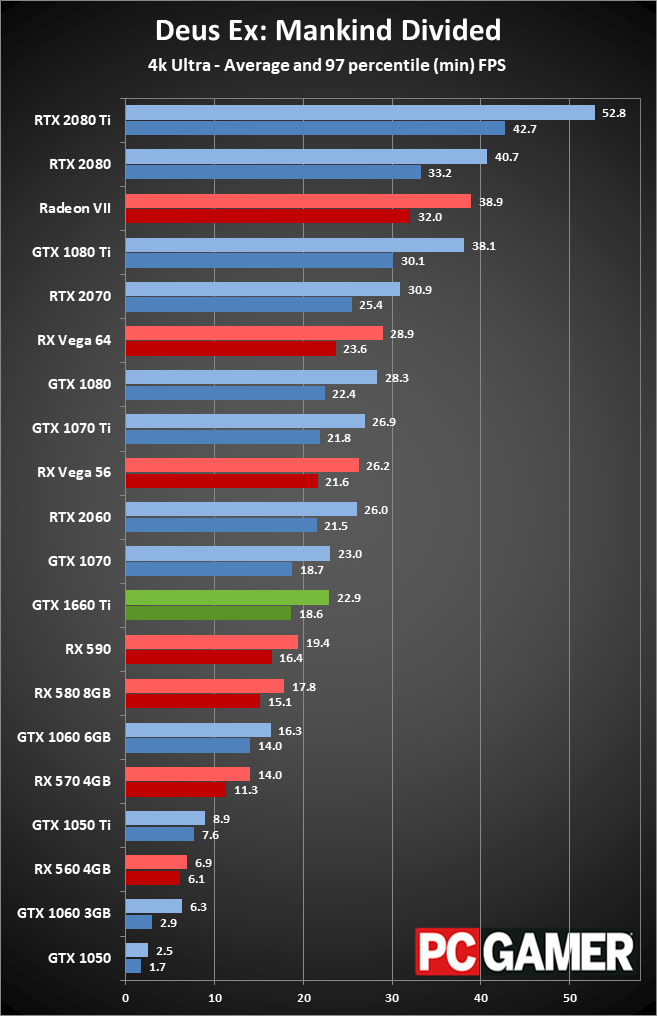
Swipe left/right for additional charts

Swipe left/right for additional charts
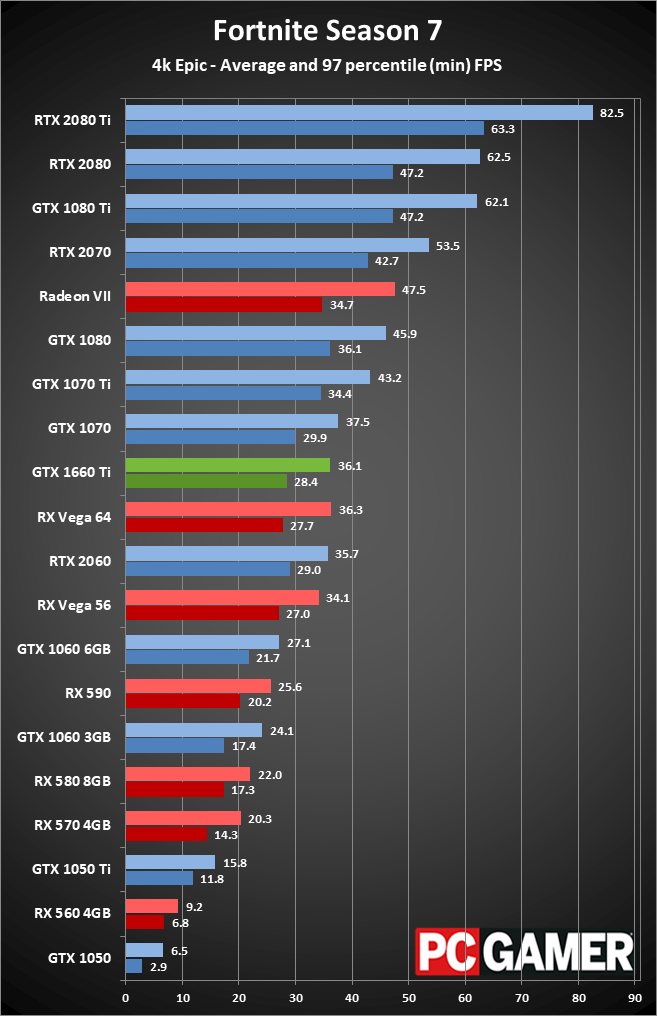
Swipe left/right for additional charts
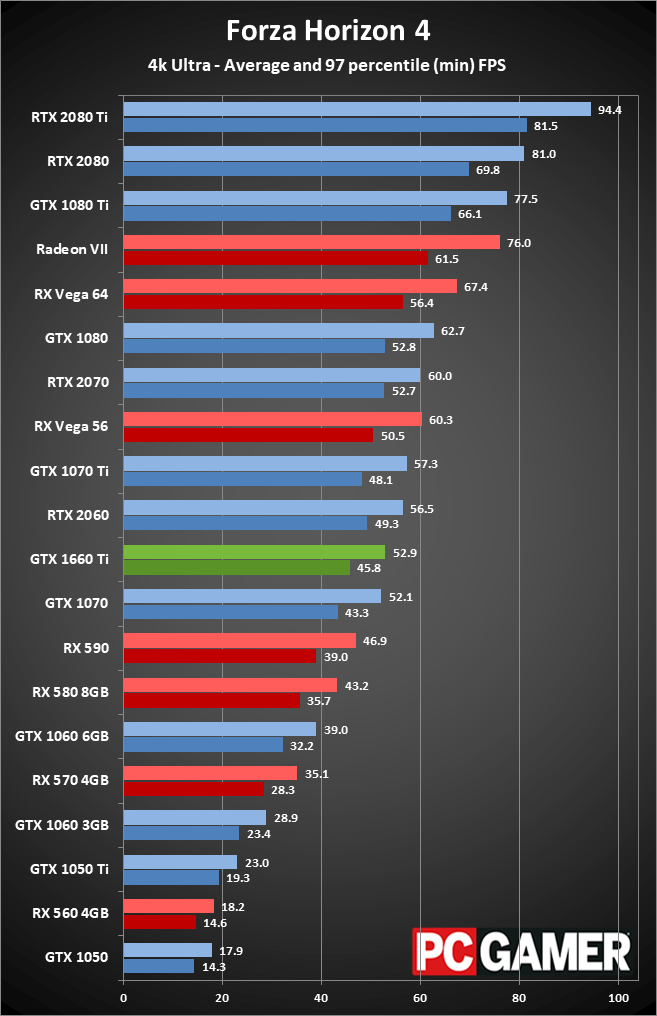
Swipe left/right for additional charts
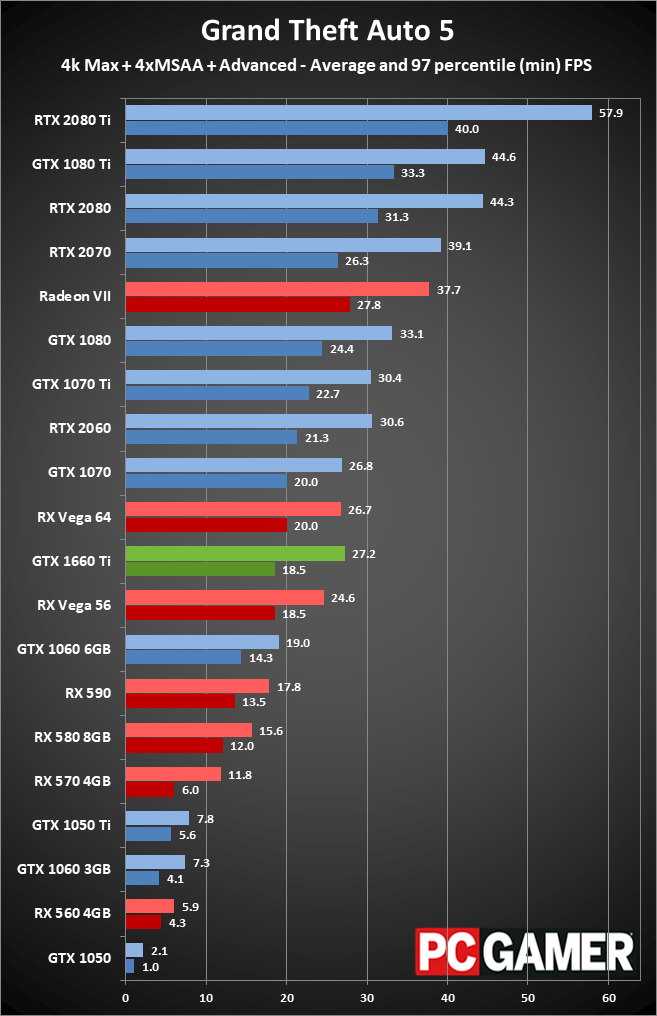
Swipe left/right for additional charts

Swipe left/right for additional charts
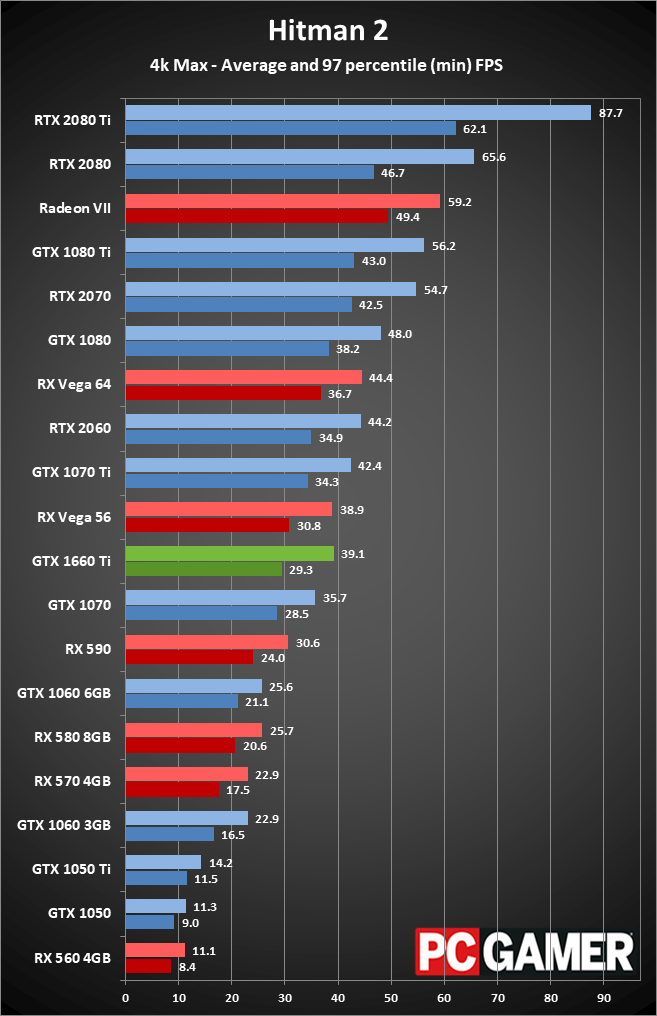
Swipe left/right for additional charts
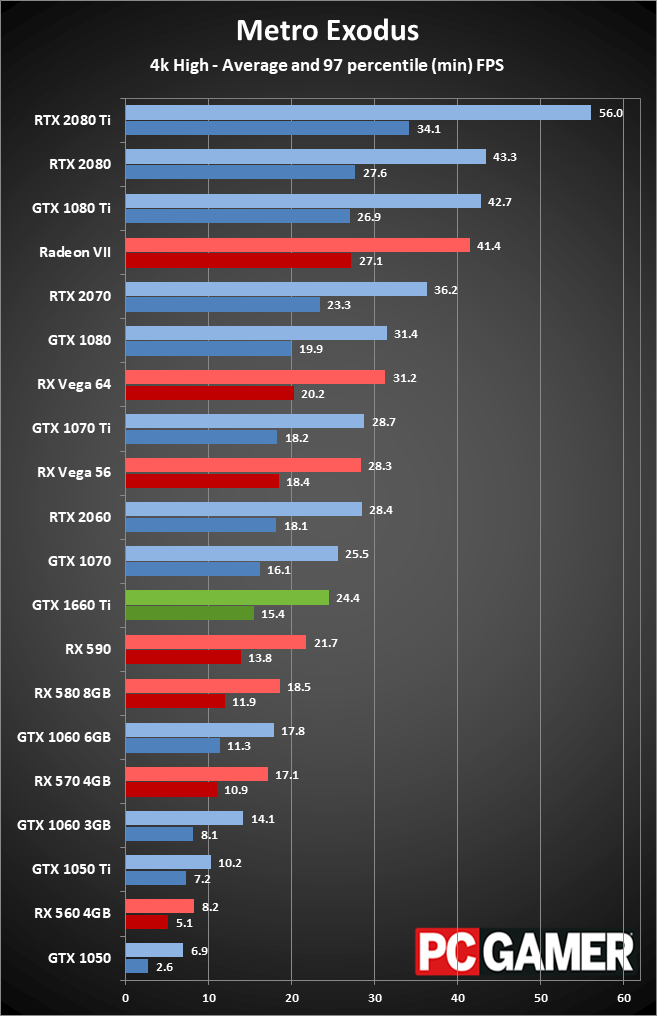
Swipe left/right for additional charts

Swipe left/right for additional charts
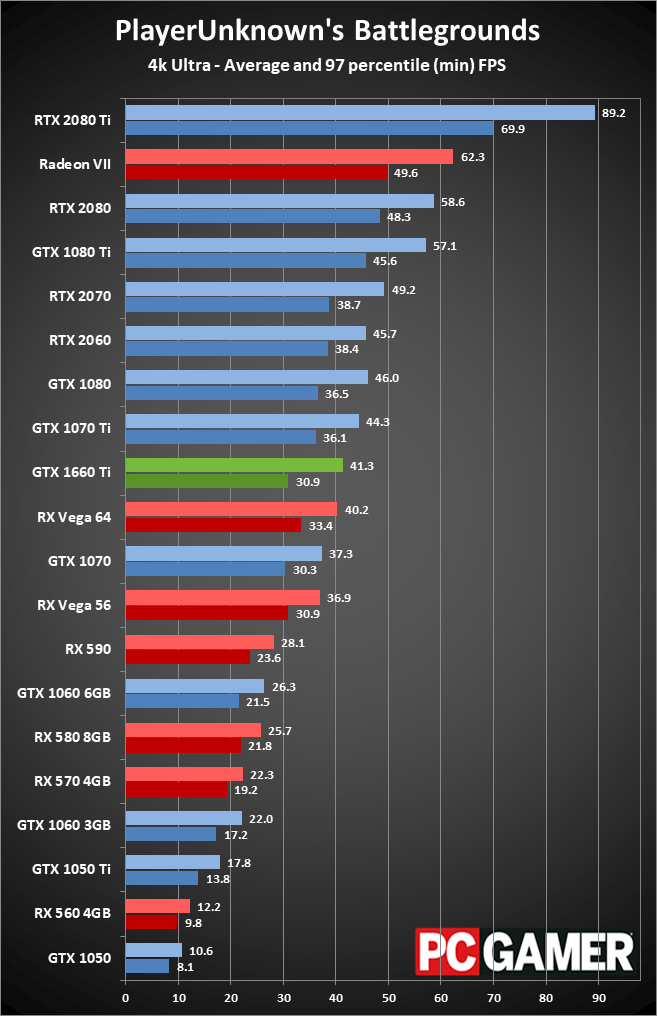
Swipe left/right for additional charts
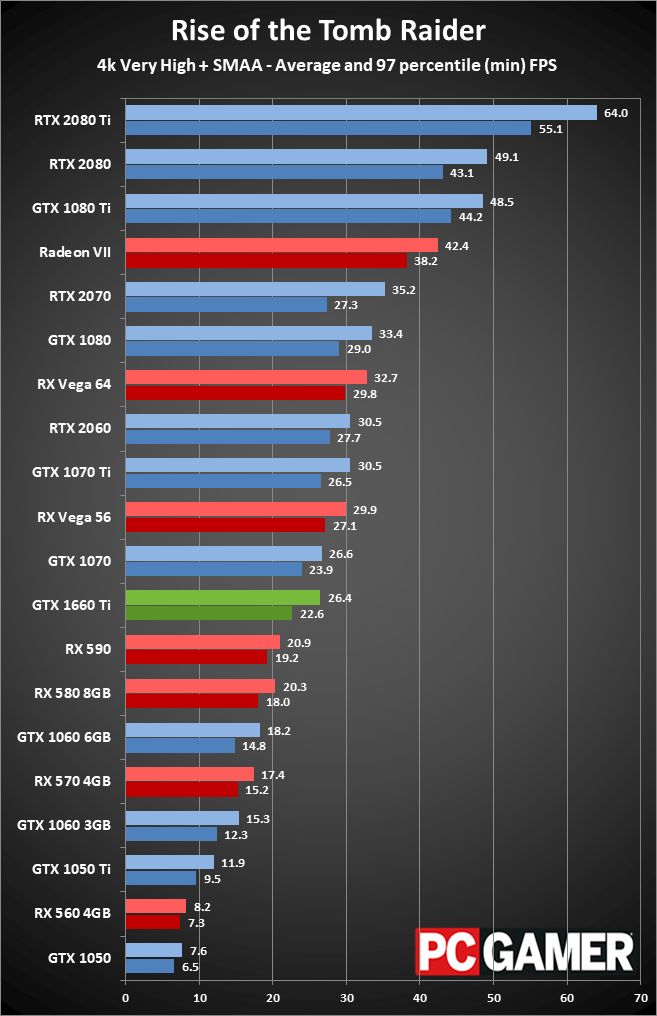
Swipe left/right for additional charts

Swipe left/right for additional charts
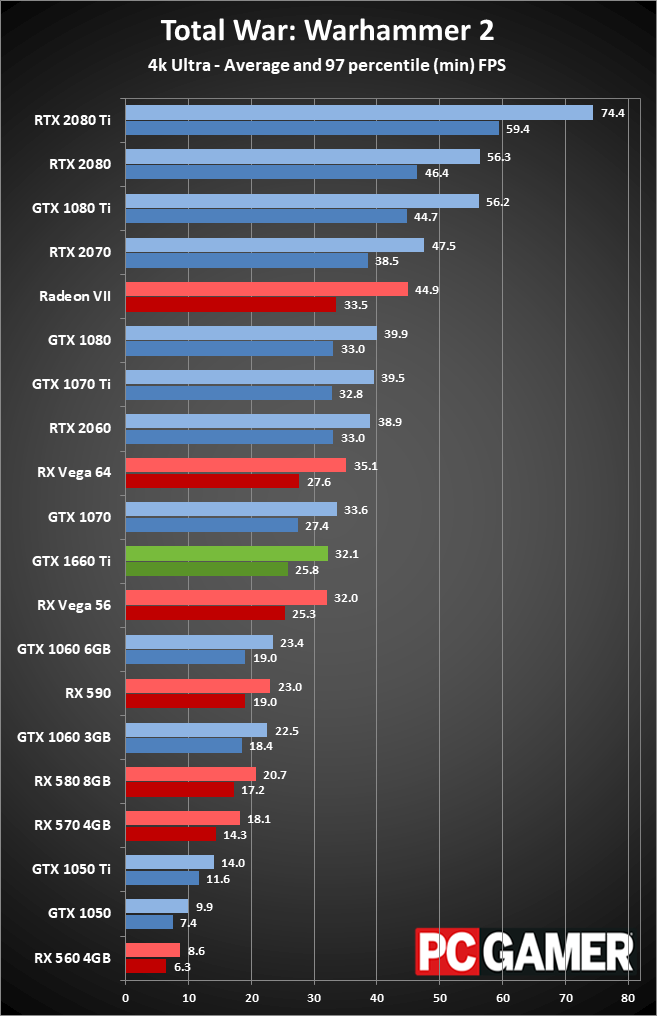
Swipe left/right for additional charts

Swipe left/right for additional charts
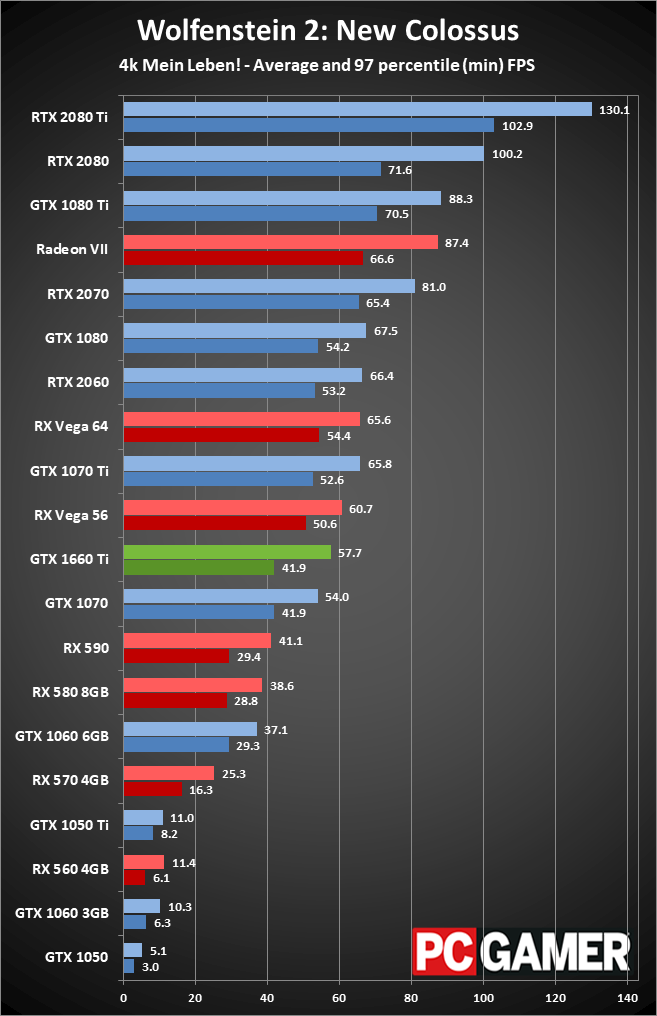
Swipe left/right for additional charts
The 4k ultra results are mostly superfluous here, but I've run the benchmarks anyway. Even if you drop the quality down to medium or low, quite a few games are going to fail to break 60fps—there are simply too many pixels to push around for a midrange card. Overall rankings are similar to the previous charts, though the 6GB VRAM does become a bit of a factor now. But again, you really shouldn't be running 4k on a card like this.
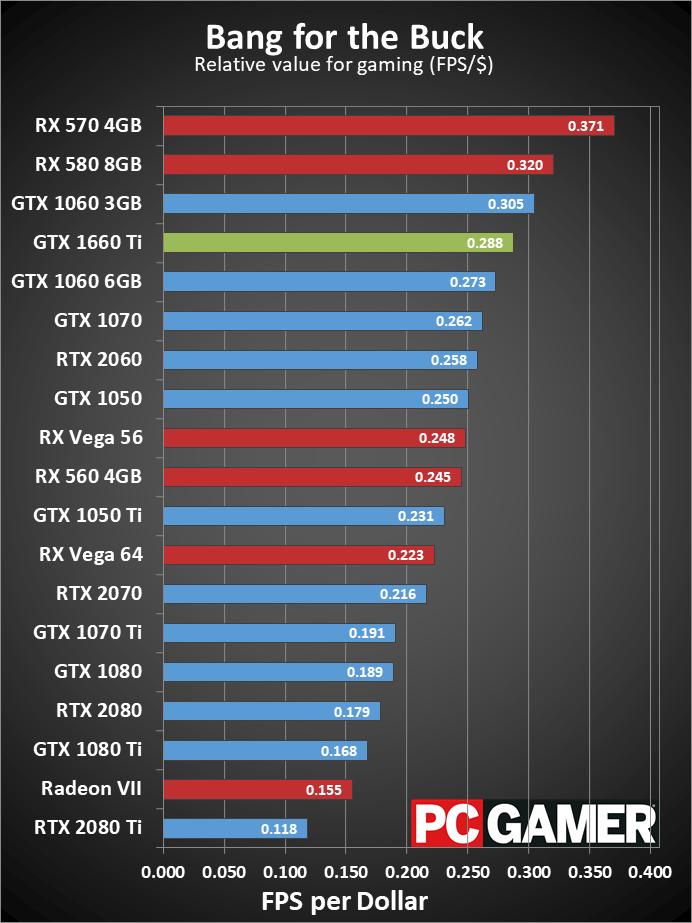
Swipe left/right for additional charts

Swipe left/right for additional charts
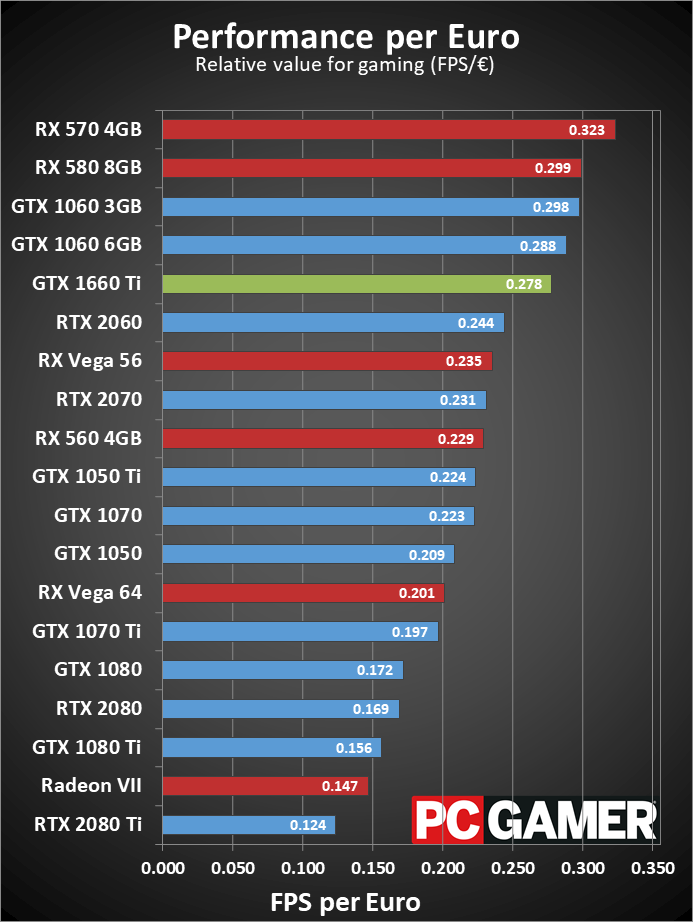
Swipe left/right for additional charts

Swipe left/right for additional charts

Swipe left/right for additional charts

Swipe left/right for additional charts
Wrapping things up, in terms of value the GTX 1660 Ti sits near the top of the midrange graphics card pile—depending on the model you're looking at, naturally. For the GPU in isolation, you could still argue that the RX 580 8GB and RX 570 4GB are better choices, which makes sense considering they cost 30 percent and 50 percent less, respectively. But the GTX 1660 Ti holds its own against the GTX 1060 cards, never mind the more expensive RTX models. Flip over to a complete mainstream build and the GTX 1660 Ti looks a lot more promising.

The GeForce GTX 1660 Ti is a welcome return of the GTX brand
You have to wonder about Nvidia's thought process on the GTX 1660 Ti. Was it always in the works? Probably, as trying to do ray tracing and DLSS on anything less than the RTX 2060 seems unlikely. But after all the hype on those new features, it almost feels like Nvidia is backpedaling a bit in giving us a new GTX series of cards. There are some new features compared to Pascal (10-series), but overall the Turing architecture only seems to account for a 10 percent improvement in CUDA core performance—the rest of the improvement comes via more cores and higher clockspeeds.
Something else to consider is when the inevitable GTX 1660 will arrive—with the Ti suffix and a fully enabled TU116 processor, obviously there's plenty of opportunity for Nvidia to release a lower spec GPU. Hopefully it sticks with 6GB VRAM, though, as anything less is becoming increasingly shortsighted. A slightly slower card priced at $200 would be welcome news, but we'll have to wait and see what happens and what the final product looks like.
In the meantime, if you've been sitting on a midrange GPU from a couple of generations back, or a high-end card from five or more years ago, the GTX 1660 Ti is a worthy upgrade. Moving from a GTX 970 or R9 380X or lower GPU to the 1660 Ti will give a significant boost to performance, and reduce power requirements as well. And if you're running a GTX 960, GTX 770, or similar GPU, the 1660 is over twice as fast. Of course, you could have gotten a similar boost in performance over two years ago with the GTX 1070, and it would have only cost an extra $100 or so. And then that whole cryptocurrency thing happened and GPU prices went haywire for a year, but thankfully that's now a thing of the past. (Knock on wood…)
It's not all sunshine and flowers with the TU116 design, though. Besides being an admission of sorts that we're not at the point where real-time ray tracing hardware is ready for the masses, it has a few areas that could become weak spots during its lifetime. It has 50 percent more memory bandwidth than the GTX 1060 6GB but the same amount of VRAM. I'm not sure when 6GB will really become "not quite enough VRAM," but more games are starting to push into the 8GB and higher range, so be prepared to drop from 'ultra' to 'high' textures in the coming year or two. It's also interesting that the chip has 50 percent more transistors than the GP106 that's in the 1060, and yet despite the 12nm lithography it's still 42 percent larger. I know, 12nm is more marketing than substance, but I'm still waiting to see when Nvidia makes the move to 7nm, and what sort of GPUs it will make then. Spoiler: they'll be faster and better than Turing, but those are likely still be a year or more away.
Right now, if you're looking to build a new midrange gaming PC, capable of running nearly any game at 1080p ultra with high framerates, the GTX 1660 Ti belongs near the top of your list. It easily outperforms Nvidia's old GTX 1060 cards and doesn't cost much more. It delivers good performance and excellent efficiency, with a price that can reach a much wider audience than the RTX line. It also does a better job at hitting 60fps or more at 1080p ultra, something that the RX 570/580 and GTX 1060 cards sometimes struggle to do, especially on the most recent crop of games. Those looking for something to last a few years while we wait for more capable ray tracing hardware to arrive (hopefully at mainstream pricing) will find a lot to like in the GTX 1660 Ti.
[Note: The score for this review is specifically for the GTX 1660 Ti GPU, not the Asus card used for testing. Individual models may warrant slightly higher or lower scores, depending on pricing, features, and other aspects of the cards.]
The GeForce GTX 1660 Ti balances price, performance, and features to create a compelling mainstream offering with improved performance for the midrange market.
Jarred's love of computers dates back to the dark ages when his dad brought home a DOS 2.3 PC and he left his C-64 behind. He eventually built his first custom PC in 1990 with a 286 12MHz, only to discover it was already woefully outdated when Wing Commander was released a few months later. He holds a BS in Computer Science from Brigham Young University and has been working as a tech journalist since 2004, writing for AnandTech, Maximum PC, and PC Gamer. From the first S3 Virge '3D decelerators' to today's GPUs, Jarred keeps up with all the latest graphics trends and is the one to ask about game performance.



